INTERVIEW BY VENKATESH RAO FOR THE INDIAN KENNEL GAZETTE (KENNEL CLUB OF INDIA) | Extended Version.
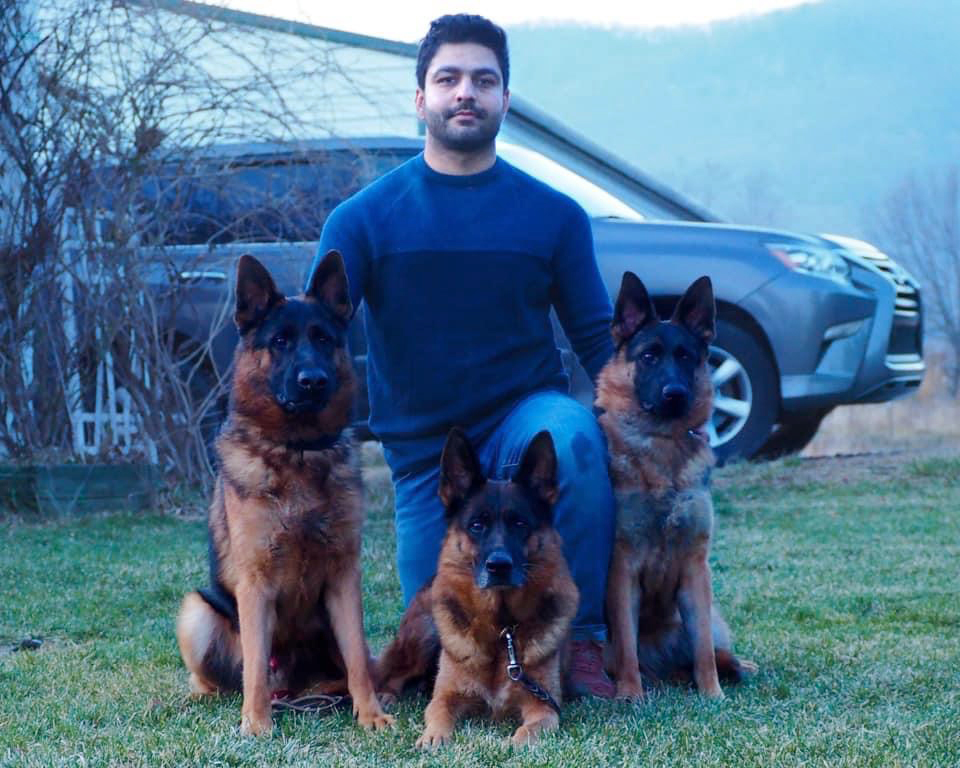
Venkatesh Rao: On behalf of the entire committee of the KCI and the Editor of the IKG, I thank you for sparing your valuable time and giving this interview and sharing your vast experience with our readers. My purpose behind this interview is to enrich the knowledge of the IKG readers towards this wonderful breed in which You have been involved over the last three decades. This interview is more special for me because I have known you personally over the last several years. Please accept my compliments on your commitment to the breed of GSDs and your success with them.
Abhai Kaul: Its my privilege to do this with you. I am thankful to the entire committee and KCI editor for taking interest in my experiences with the German Shepherd Dog. In my childhood, pre internet, the IKG coming in the mail was one of the highlights, so doing this for the beloved Gazette that brought knowledge and entertainment to many a dog lover in India, feels like coming full circle. You and I share a common love for the German Shepherd Dog, and have become dear friends over the years. I am grateful for the dogs to introduce me to you and a few other of our friends that I would not have met had it not been for these amazing creatures.
VR: Could you tell us a little bit about how did your journey with the German Shepherd Dogs start, did you have other breeds what made you choose the GSD over others ?
AK: My journey with the GSD started in my preteen years when I had rescued a male that was going to be abandoned due to ‘uncontrolled aggression’ as it was called. Somehow I convinced my family to let me have the dog, of course they didn’t know his background, but the dog just needed an outlet and he never had any incidents for the rest of his years, and lived harmoniously with other dogs and people, even though ours being a busy household with several pets, help, visitors etc. My family raised Tibetan Mastiffs before I came into this world, and down the years, the household saw different breeds like Dachshunds (which I won a few best in shows with) and Labradors of which I bred a couple of litters and competed when I was able to get time away from school with a male and a female in North India. But once the German Shepherds came into my life, there was no looking back; They were more intelligent, driven and powerful than all the dogs that I had chanced upon thus far, and I’m still going strong with them several years later.
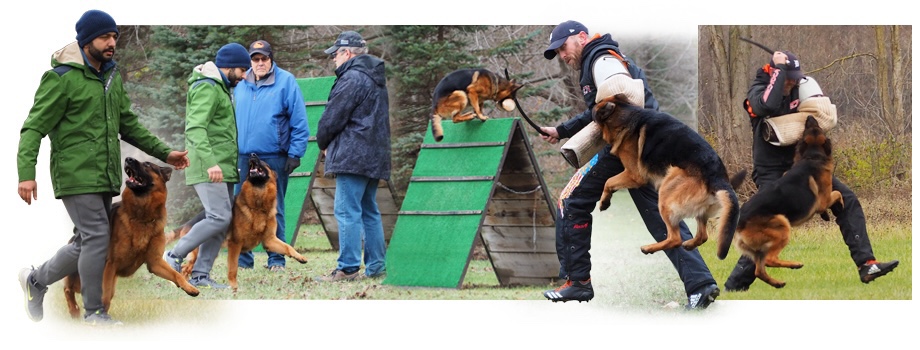
VR: Could you please give us the story behind choosing the name for your kennel?
AK: The Literal translation is of course #1 written out in the German language. I do realize that might lend a speck of arrogance to the name, but that was only an unintentional side effect. The name came about when I was around 15. I looked at the kennel names that were around then and most still are now, and realized that they were either to do with the names of the people or the area where they were from. This is a time when I was obsessed with having the perfect dog (To my relief, I realized later that sentiment is but a mirage.)
My thought was the names certainly don’t reflect upon the dogs that these great kennels had, just the breeder’s origins. I wanted mine, naturally, to be different from what everyone else seemed to be doing. So instead of the apparent traditional route, I chose something that in my mind represents a philosophy and an attitude more than anything else, and a manifestation of that ideal is “Nummer Eins”.
Excellence isn’t measured in trophies but by countless years in this beautiful endeavor constantly striving for perfection, trying to best yesterday.
It exemplifies the desire to succeed at the end goal – Breeding consistently my interpretation of the breed standard, the versatile German Shepherd. It stands for prioritizing important components of a breeding program like health, temperament and structure. Perfection is merely an illusion but the relentless pursuit of it can lead to excellence and the journey endured towards that goal can be defined as “Nummer Eins”.
VR: Do you have any kennel staff ? Any one from the family who family who helps you with the dogs ? How much time does one need to spend on a dog on a daily basis ?
AK: Dogs are very much a family affair for us. Its just my wife and I that take care of our pack. They are the members of our household and keep us quite busy. Several dogs we own are now older (10 plus years) that have lived long, active lives and are now living out their golden years with us. There’s a sentiment in Hawaii of “Kahu” which I draw inspiration from. Kahu has many meanings; among them guardian, protector, steward, someone entrusted with the safekeeping of something precious, something cherished. What a Kahu protects is not his/her property but a part of their soul. This is what these dogs mean to our family.
I feel that if you don’t personally care for your dogs everyday needs, you don’t fulfill the basic tenants of service to that animal and hence Dogsport. Dog ownership doesn’t take holidays and weekends off. Since my teenage years, I convinced myself to build a life around my dogs, with that in mind, I molded my personal and professional life around that goal.
Dogs need individual time, but more than long hours each day, they need consistency in routine. One can’t spend two hours working on a thing one day, and not work on it for the rest of the week. Additionally, keep sessions short, spirited and positive build drive and anticipation and make the interaction fun for both you and your dog.
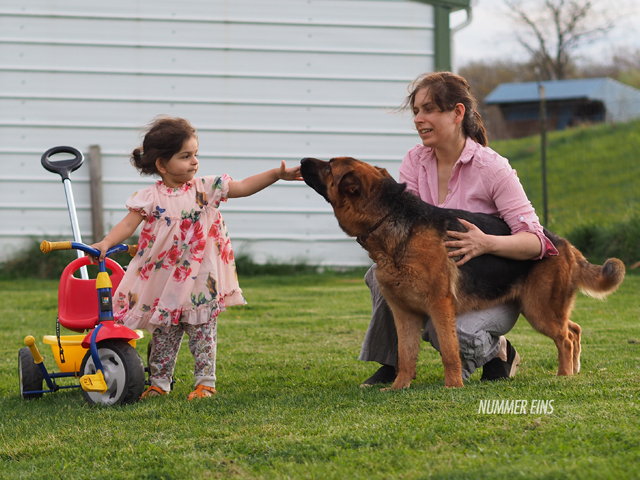
VR: I see that all your dogs are show GSDs but also have been titled in sport which is very unique considering the breed is now classified into show & working , how did you manage to keep it unified ?
Here’s why the argument of show line and working line is a deflated one in my opinion. We have one breed. We have one breed standard. All dogs fall on a spectrum of that breed standard and then you have breeders specifically breeding for a couple of traits. Whether it’s higher and higher drives or whether it is pronounced angulation and affinity to a particular color of coat. Styles of dogs people prefer doesn’t lend itself to removing dogs from the gene pool as breeding preferences.
I’ll cite examples from my own dogs. My current male that I’m competing with Lupin Dell’Alto Piano IGP1, ANG. is a high drive, dominant high caliber dog as far as the sport of IGP is concerned, but he also has a correct overline, a correct underline, correct height to length proportions and correct height to depth proportions with excellent black parts, a correctly shaped head and ears, straight in front and back while moving and shows great spirit while he moves. One might like his type or might not like his Type. That’s upon the interpretation one holds of the standard which is for most people by consuming pictures on social media. But it would be a fallacy to say this dog shouldn’t be bred from to improve firmness and correctness in build, and drive, doesn’t matter how diverse or myopic one’s opinion on type and lines is.
The converse of this is also true. My male V1 O’Stryder von Nummer-Eins IPO3, FH1 Ang. comes to mind, a very attractive looking male of the right size, bursting at the seams with drive, loved to work, loved to eat, super intelligent and courageous. A natural tracking dog and a dog with natural retrieves and jumping ability. All while having a superb forehand, correct overline and angulations, deep red black color with nice coat. I was often asked if he had working lines in his pedigree by people who saw him work, and my response was He’s a German Shepherd Dog, of course he must work.
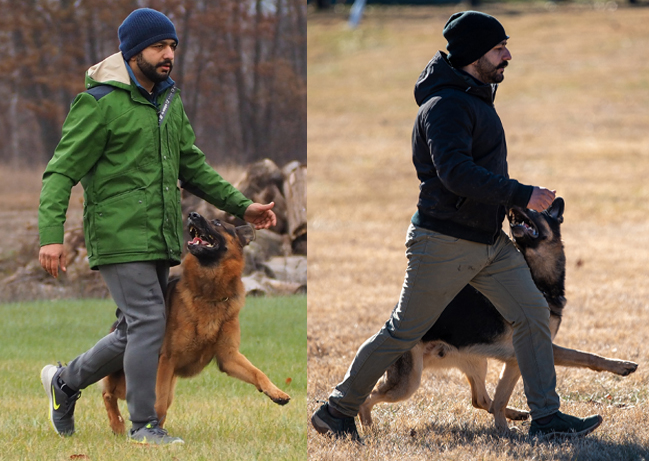
VR: How different are your dog’s when you compare them with other breeders ? do they do well inside the houses along with kids ?
AK: I am looking to breed and raise dogs that are true to the breed standard. The Breed Standard clearly defines that the German Shepherd Dog is a working dog, and its a dog that can fit in many roles and do them well. The founder of the breed was insistent on this very character, which is very much what the dogs are about. By work I don’t mean walking in a ring, as that seems to be the consensus in India: I mean a dog that is willing to engage in any job asked of it. Also, the dog must have correct anatomy along with good temperament and drive to support that drive. A dog that keeps getting injured because of imbalance in structure due to excessive angulation is again a not a dog that follows the breed standard and hence is not a good representative of the breed if he or she is not of a robust build with firm ligaments. Furthermore, the breed though a pastoral breed, is not a livestock guardian breed, so the demeanor of the around its own people is very important. A German Shepherd should crave its people. You should be able to live with your dog, the dog must be okay with your family, and aloof of strangers. If you want a dog to go socialize with everyone, get a Golden Retriever. A German Shepherd is a protector of the home and hearth. The analogy I like to use is if any key can open your lock, what good is your lock?
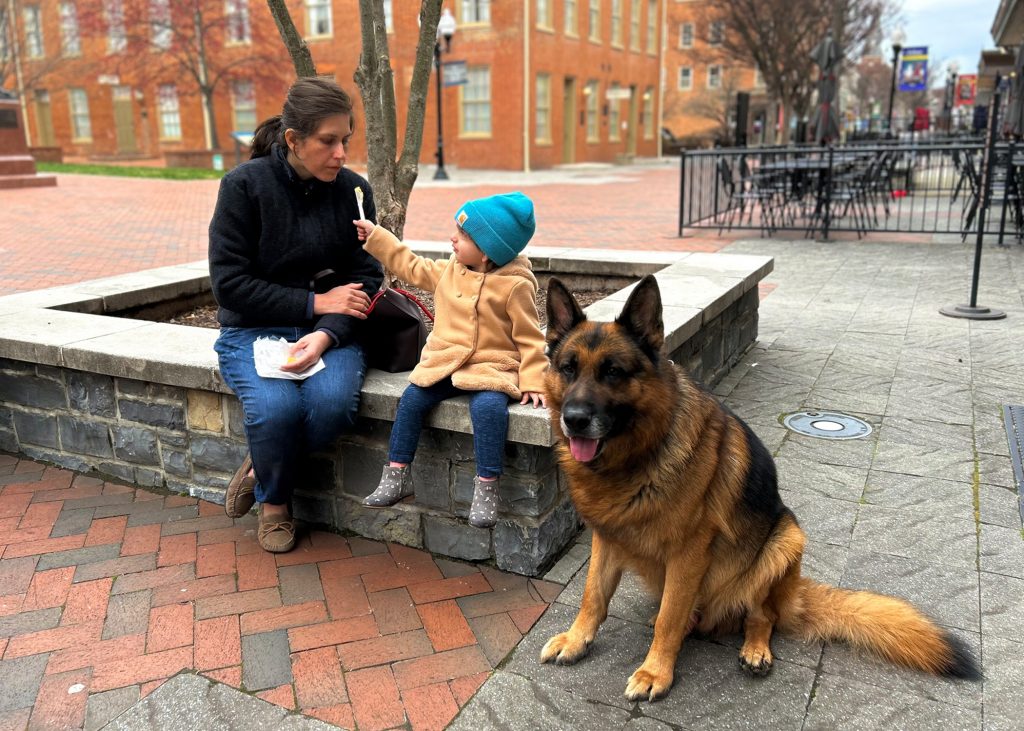
VR : The German Shepherd dogs have evolved with time , now there are sable and Bi color and black are classified as working, even the structure is being classified what is your take on it and your message to our readers ?
AK: Calling it evolution would be to mischaracterize the way the dogs have gone. A better word would be overtypization of the dogs towards one extreme or the other. I can be honest and look inwards into the breed and say that the winners of today are not what the standard reflects because they’re not functional dogs whichever side of the spectrum we look at. We pride the German Shepherd Dog being the ideal golden middle that combines the virtues of anatomy and character to be the ideal everyman dog, but in an age of labels of “Do Not Drink” on paint cans, common sense seems to be fleeting.
We have developed collective amnesia as enthusiasts. The dogs like Iso von Bergmannshof (a Black Brown dog) and Troll von Bösen Nachbarschaft (a Bi Color dog) didn’t exist too long ago. Looking at the winners of today you sometimes scratch your head but of course one can only pick a winner from the dogs presented.
If you speak with any breeder or judge involved with the dogs for a few decades, and I have had a chance to speak with quite a few and have been able to interview some (which are available for all to see onYou Tube) they will tell you this divide did not exist in the past, and dogs were utilized for their individual attributes, not for the style of pedigrees behind them.

VR: Often when we talk about working shepherds we hear the terms DDR ,Czech, What is a DDR, we often hear that this is from west German lines, or East German lines or a Czech blood line GSD? which is one better? are these again sub types or there is a rationale behind these classifications ?
AK: DDR was simply the Deutsche Democratic Republic (which was called East Germany) before the Berlin wall fell in the late 80s, and the dogs within were the DDR or East German Dogs.
After the second world war, Germany had been divided into two nations West Germany and East Germany or DDR. There was a nonporous border between the two newly formed nations, with the west being open to Western Europe and the Americas, while the east was under strict Soviet control, hence restricting their access to the dogs in West Germany and elsewhere, and the breeds started developing in separate populations. This was also the time when among others, the Martin brothers (Wienerau, Arminius) were getting established in West Germany and their choice of dogs were becoming a global phenomenon: which started to turn into the showline dogs in the late 70s, early 80s.
To counter the limited gene pool imposed by geo-political restrictions, the East Germans developed an innovative breed survey to evaluate their dogs. This was known as the Wertmessziffer system of DDR selection. This breed survey, much like the current survey system, follows the initial licensing and relicensing, but unlike the current system, it was scalar in nature. For instance, the rating of 5555/55, where the first 4 digits are out of 0-9 and the last two are 1-5, evaluate the Body type, Physical
Constitution, Angulations and Hip gradings. The next two refer to Environmental Sensitivity/ threshold, Level of Aggression and the Hardness or Mental Resilience to Pressure.
These allocated numbers would determine the best case use for the dog’s future occupational utility. So, a dog that would find a home as a schutzhund prospect, would look for a 5555/55 rating. The German Shepherds that were lower in the initial parameters like Body Type, Physical Constitution, could be used for guarding or police work.
With Germany not being a very big country, to contextualize for the American audience, The entire country of Germany is the size of the state of Wisconsin. So after the collapse of the wall, when Germany was united again, to assume the dogs which came from a concentrated genepool in the east stayed isolated as they were in the cold war era, would be unrealistic.
The Czech Republic again being a very tiny country in Eastern Europe was restricted very much by the same geo-political global hegemony and benefited greatly with the west opening up, not only to show case their talents as excellent trainers but also to a new larger market where their breeding talents found new connoisseurs. They did not have the control or restrictions of the East German Breed Survey system mentioned above, so the dogs that were bred there were valued only for drive that could be utilized in IGP competitions to great effect, no consideration was paid to anatomy or the other mental aspects of these dogs.
This moniker has now been reduced to a marketing gimmick which some people unfortunately use as a USP to sell their puppies to unsuspecting and uneducated buyers who are too lazy to do their due diligence.
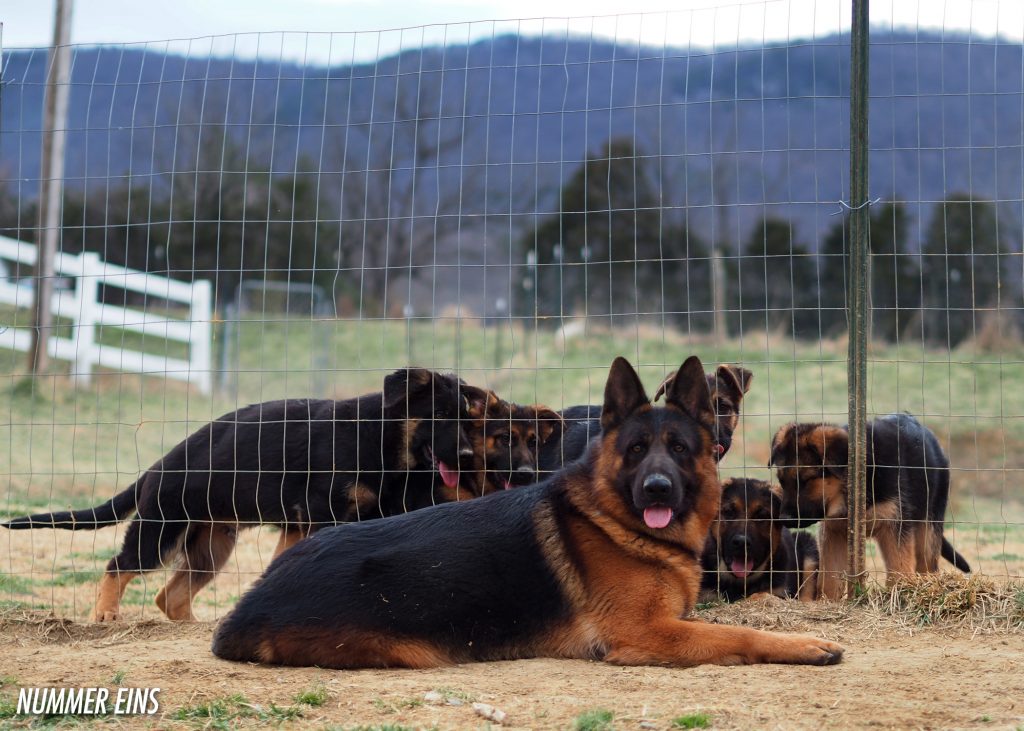
VR: What are the health parameters you look into when you breed , or when you are selecting a puppy ?
AK: When selecting a puppy I am looking for harmony and balance in movement. I am looking for puppies that are straight limbed, that are firm, that love to eat, that love to explore, that are engaging and curious. I test my puppies by taking them to areas that they’re unfamiliar with and observe how they act, and like pups that are engaging and don’t skip a beat when their environment is changed. Those are the dogs that will be unfazed when presented with challenges in their life down the road. Being cautious is natural, but recovering and adapting is the sign of a sound character. The puppies that reach their baseline in new situations are the type of puppies I like.
VR: What according to you is the right age to start training and competing with a GSD and what according to you is a life span of a healthy dog?
AK: In the states the earliest the puppies leave the breeder is 8 weeks. I like to hold on to the puppies for a few weeks longer because I want to observe them as they grow a
bit further. This is all extremely interesting to me, how their drives shift, how their hierarchies change, how they interact with their environment is all of key importance to me to inform me when they have their children so I can create patterns and continue existing patterns that I have established. Again, in my experience, From my lines, I have dogs living well into their mid teens.

VR: What are your views on DNA, pedigree papers and their importance etc? Did you ever check your pups DNA when you got it from other kennels?
AK: Documentation of lineage of course is very important. As an parallel analogy, the Vedas were written approximately 5000 years ago. and its said that they were an oral tradition before that for thousands of years. No one can accurately say what all knowledge has been stolen from mankind in way of cataclysms, natural disasters, wars and invasions when we lost great scholars and ascetics that carried this knowledge in their oral tradition in Ancient India. Coming back to the dogs, Outside of pedigrees, I keep meticulous notes on dog behaviors of each line, of my personal experiences with them, their behavior patterns, their eating habits, their drive states as they grow and what they exhibit as families and the traits they pass on to the next generation, which someday down the line I might publish if there’s enough interest for people to learn. So of course Not only do I think that pedigrees and DNA are fundamentally important, I think the records must go much further, and the Breed Survey document is a step in that direction for standardization of description of the dog’s anatomy and demeanor.
VR: Could you highlight the importance of the Breed Survey and what it encompasses?
AK: At its core, the German Shepherd Dog Club of America National Breed Survey serves as a showcase of the finest qualities of a German Shepherd dog and enables him or her to compete worldwide in every WUSV country. Provided the set guidelines are met (of health evaluation, earning working titles), in theory this document is attainable for every German shepherd.
The survey is more than just pageantry for dogs. It’s a dynamic platform that empowers breeders, enthusiasts, and researchers to make informed decisions that positively impact the breed’s genetic health and temperament. The meticulous evaluation conducted during the survey provides a window into the breed’s overall well-being, highlighting strengths and identifying areas that may require attention.
This insight aids breeders in making responsible breeding choices, ensuring that the next generation of German Shepherds inherits the best possible attributes.
Beyond its significance in preserving the breed’s physical attributes, the National Breed Survey plays a pivotal role in nurturing the breed’s character. German Shepherds have earned their reputation as loyal and dependable companions, traits deeply ingrained in their genetic makeup. Through the survey, breeders and Breed Surveyor or körmeister assesses not only anatomy, dentition and coloration and pigmentation but also temperament, behavior, and trainability, contributing to the development of dogs that
excel as both working partners and beloved family members.
VR: We know that commercial trends sometime garners takers, off lately, India as a country too has seen white German shepherds, brindle and also King German Shepherds, in country where there is not much of knowledge impartation how does one do his homework?
AK: Greed is a global phenomenon, its not just restricted to India. Its often the case when you have a breed that is so popular with worldwide acclaim like the German Shepherd Dog, you will have unscrupulous people trying to make a quick buck, preying on unsuspecting people.
The Breed Standard is essentially a blueprint that outlines the ideal characteristics of a particular breed, in this case, the German Shepherd. It covers everything from physical attributes to temperament, ensuring that the breed’s integrity and purpose are preserved. As a responsible breeder, you must always adhere to these standards because they’re crucial in maintaining the health, functionality, and distinctive qualities of the German Shepherd breed.
Now, when it comes to puppy mills selling white, blue, liver and brindle dogs as rare German Shepherds, it is deeply concerning. The German Shepherd breed standard, as established by the FCI and SV, does not recognize these colors as acceptable within the breed. The breed’s coat colors are primarily black and brown, sable, or solid black. This is because the breed’s historical and functional qualities are rooted in its traditional colors.
Puppy mills, unfortunately, prioritize profit over the welfare of the dogs they produce. They often disregard the breed standard and sound breeding practices in favor of producing puppies as quickly and cheaply as possible. Selling white and brindle dogs as “rare” German Shepherds is not only misleading but also undermines the breed’s heritage and health. These dogs might not possess the desirable traits that are associated with German Shepherds bred responsibly, which can lead to temperament issues and health problems.
White German Shepherds, for example, are more prone to certain genetic health issues, including deafness and skin problems. Breeding for brindle coats can also lead to a range of health concerns, as it’s not a naturally occurring color in German Shepherds. Reputable breeders aim to prioritize the health, temperament, and overall well-being of the dogs they produce, rather than simply capitalizing on unusual colors to attract buyers.
It’s important for potential puppy buyers to be aware of these issues and to seek out breeders who prioritize the breed’s standard, health, and temperament. Supporting responsible breeders who follow ethical practices helps ensure that the German Shepherd breed maintains its integrity and continues to be the loyal, intelligent, and versatile working dog it’s known to be.
VR: In India, Long Coats are setting the trend these days with sellers proclaiming that this variety of the breed is firmer, more intelligent etc. Could you please enlighten our readers?
AK: Long Coats have been an integral part of the breed since its inception, dating back to the original dogs that were the precursor to the breed before its creation. In the modern breed standard, the Long Stock Coat is a coat variety where the outer protective coat is longer and denser. The length of hair has no impact on firmness or intelligence of dogs.
The Breed Standard is the cornerstone of responsible breeding practices, ensuring that the qualities that define the German Shepherd are preserved for generations to come. Puppy mills that exploit non-standard colors not only compromise the breed’s well-being but also perpetuate a cycle of irresponsible practices. Its the duty of established breeders and clubs to work together to educate potential dog owners about these matters and encourage a responsible approach to breeding and acquiring dogs. Also, in the age of internet, information is easily available and some responsibility also falls on the new owners to do their due diligence and ask as many questions as they can, meet and speak to as many breeders as they can, visit several events to see what type of dog they like and can actually live with.


VR: When people approach you for a pup or a dog from your breeding do you have any check list or a criteria ? did you ever reject a prospective buyer ?
AK : Since I don’t breed too often, I have the luxury of being picky with the homes that my dogs and puppies go to. It is of utmost importance to me that the dog will be loved for itself first and not seen as an investment or commodity to capitalize on by the future owner, neither do I want it to be a yard ornament that the prospective owners want for the sake of having. These are highly intelligent dogs that want their people and need a job.
I have a strict checklist and set of criteria when people approach me for a pup or a dog from my breeding. The well-being of the dogs and the preservation of the breed’s qualities are my top priorities. I’m committed to ensuring that each dog goes to a loving and responsible home where their needs will be met, both physically and emotionally.
Here’s an overview of the criteria I typically consider:
● Lifestyle Fit: German Shepherds are intelligent and active dogs that require mental
stimulation and physical exercise. I assess whether the potential owner’s lifestyle can accommodate the breed’s activity level and training needs.
● Living Situation: I inquire about the living environment, whether it’s an apartment, house with a yard, or rural property. It’s important that the space is suitable for a German Shepherd’s size and energy.
● Knowledge of the Breed: I like to ensure that potential owners are knowledgeable about German Shepherds and their characteristics. This helps me gauge their understanding of the breed’s needs and whether they’re prepared to handle them.
● Purpose: Depending on the dog’s lineage and potential, I might ask about the intended purpose for the dog – whether it’s a family companion, a working dog, or a show dog. This helps me match the right dog to the right home.
● Commitment: I discuss the long-term commitment required for a dog’s care, which includes training, socialization, veterinary care, and exercise. German Shepherds thrive when they’re part of a committed family.
● Previous Experience: While it’s not a deal-breaker, having experience with similar breeds or larger dogs can be beneficial. It indicates that the potential owner understands the responsibilities involved.
● Financial Stability: Caring for a dog involves expenses, including food, healthcare, and grooming. I ensure that the potential owner is financially prepared for these responsibilities.
● Time Availability: German Shepherds are social dogs that require interaction and companionship. I inquire about the amount of time the potential owner can spend with the dog.
● Training Plans: I discuss the potential owner’s plans for training and socializing the dog. This is crucial for the dog’s behavior and overall well-being.
● References: I might ask for references from veterinarians or other professionals who can vouch for the potential owner’s responsible pet ownership.
Yes, I have rejected prospective buyers in the past. If I feel that an individual or family doesn’t meet the criteria I’ve set or if I sense that they’re not fully prepared for the responsibilities of owning a German Shepherd, I will politely decline. My goal is to ensure that each dog I breed goes to a home where they will thrive and be loved for their entire life. It’s a challenging decision, but it’s in the best interest of the dogs and the breed as a whole.
Could you shed some light on the popular health issues the breed suffers from and how can one be careful while buying and raising a puppy ? what’s more important the genetics or the raising ?
Of course, I’d be happy to provide some insight into the common health issues that the German Shepherd breed is prone to, as well as tips on how to approach buying and raising a puppy to mitigate these concerns.
Common Health Issues:
● Hip and Elbow Dysplasia: German Shepherds are prone to hip and elbow dysplasia, which are developmental issues affecting the joints. These conditions can lead to pain, lameness, and reduced mobility.
● Exocrine Pancreatic Insufficiency (EPI): EPI is a condition where the pancreas doesn’t produce enough digestive enzymes, leading to poor digestion and nutrient
absorption.
● Gastric Dilatation-Volvulus (Bloat): Bloat is a life-threatening condition that can affect large, deep-chested breeds like the German Shepherd. It involves the
stomach filling with gas and twisting on itself.
● Allergies: German Shepherds can be prone to skin allergies and sensitivities, often leading to itching, redness, and discomfort.
● Panosteitis: This is a condition where there is inflammation of the long bones, causing lameness and pain. It’s more common in young, rapidly growing dogs.
Buying and Raising a Puppy:
● Choose a Reputable Breeder: When buying a German Shepherd puppy, it’s crucial to source one from a reputable breeder who prioritizes health and adheres to responsible breeding practices. A reputable breeder screens for genetic health issues, provides proper care to the puppies and their parents, and is transparent about the dog’s lineage.
● Health Testing: Reputable breeders conduct health tests on their breeding dogs for common genetic issues. Ask for documentation of these tests to ensure you’re getting a puppy with a lower risk of inherited health problems.
● Socialization and Training: Proper socialization and training play a significant role in a dog’s behavior and overall well-being. Introduce your puppy to various people, animals, environments, and experiences during their early months to help them grow into well-adjusted adults.
● Nutrition and Exercise: Feed your puppy a balanced and high-quality diet that supports their growth and development. Ensure they get the right amount of exercise for their age and energy level, while also being cautious not to over- exercise growing joints.
● Regular Veterinary Care: Schedule regular check-ups with a veterinarian to monitor your puppy’s health, administer vaccinations, and address any concerns promptly.
Genetics vs. Raising:
Both genetics and raising are vital components in a dog’s well-being. Genetics play a significant role in determining a dog’s predisposition to certain health issues. Responsible breeding that focuses on minimizing genetic risks can certainly contribute to a healthier start in life. However, proper raising, including nutrition, exercise, training, and socialization, can greatly influence a dog’s overall health and behavior as they grow.
Think of genetics as the foundation and raising as the structure. Good genetics provide a solid base for a healthy life, but proper raising is what builds upon that foundation to create a well-rounded, healthy, and well-behaved dog. Both aspects are interconnected and equally important for the long-term health and happiness of your German Shepherd Dog.
VR: Since we all know your achievements on the conformation shows , do you still show your dogs ? do you also participate in working competitions ? What is it like? could you shed some light on it ? Was it the sport that brought you to the breed or vice versa?
AK: I am not actively campaigning any dogs for a few years, but I am getting their show ratings as they are required for the breed survey. Being a new father can certainly throw a wrench in your dog competition plans. Yes I actively participate in working trials as both a competitor with my own dogs, as a protection helper to test dogs in the Phase C of IGP and also as a coach and team mate of my fellow club members to help them achieve their goals. It was neither sport nor the shows that attracted me to the German Shepherd Dog, it is what i call the Rin Tin Tin ideal which holds a special place in the hearts of many German Shepherd enthusiasts, including myself. Rin Tin Tin was a legendary German Shepherd dog whose incredible intelligence, loyalty, and versatility captured the imagination of people around the world. This iconic dog’s story not only showcased the breed’s remarkable capabilities but also demonstrated the deep bond that can develop between humans and their four-legged companions.
Rin Tin Tin’s journey began on a battlefield during World War I when he was rescued by an American soldier named Lee Duncan. This remarkable dog went on to become a symbol of loyalty, courage, and devotion through his numerous appearances in films and television shows. His ability to perform a wide range of tasks, from acting to search and rescue, demonstrated the breed’s exceptional intelligence and versatility.
What attracted me to the GSD was the breed’s unique combination of qualities. These dogs are not only stunning in appearance but also possess an unmatched work ethic, loyalty, and intelligence. The breed’s strong protective instincts and dedication to their owners make them incredible companions, whether in a family setting or in specialized roles like search and rescue, police work, or service dogs.
Rin Tin Tin’s legacy highlights the potential of the German Shepherd breed to excel in various roles, which is why I was drawn to them as a breeder. Breeding German Shepherds means not only preserving the breed’s physical characteristics but also nurturing their mental and emotional attributes. The ability to produce dogs that embody the Rin Tin Tin ideal—loyal, intelligent, trainable, and versatile—is a rewarding endeavor that honors the breed’s rich history.
Every time I look at the dogs I’ve bred, I’m reminded of the remarkable legacy of Rin Tin Tin and the breed’s capacity to forge deep connections with humans while contributing to society in meaningful ways. This ideal continues to inspire my commitment to responsible breeding, ensuring that the German Shepherd breed remains a symbol of excellence and devotion for generations to come.

VR : I have always seen you handle your own dogs ? do you have a local club where you go and take & lend help ? what is the importance of team work in a dog sport and the importance of a club ?
I am very picky about handling and presentation and feel the best way to not be aggravated is to do it myself, so when we fall short I have no one to blame but myself. We do have a small group of enthusiasts that have a German Shepherd Dog Club of America recognized club by the name of OG Horand Hundesport, which is the namesake for the first German Shepherd Dog ever registered by the Rittmeister Von Stephanitz. We try to work towards the ideal of the all round German Shepherd that he had envisioned that is capable of fitting any role assigned. We have organized a few club trials, shows, breed surveys and character assessment tests for people to come participate in and earn their titles. Engaging in dog sports is not just a solitary endeavor; it’s a collaborative effort that requires a dedicated team and a strong sense of community. While training and competing with your dog might be at the forefront, building a supportive network around you is essential for success and enjoyment in the world of dog sports.
Team Effort:
Participating in dog sports involves a variety of skills and expertise that go beyond individual capabilities. From training techniques to handling strategies, there’s a wealth of knowledge to be shared. Having a team that includes trainers, mentors, fellow competitors, and even friends and family provides valuable perspectives and insights. Different individuals bring unique experiences to the table, helping you refine your training methods, tackle challenges, and uncover new strategies.
Community Building:
Dog sports enthusiasts form a vibrant community bonded by a shared passion. This sense of belonging can be incredibly rewarding. Through competitions, training sessions, workshops, and events, you have the opportunity to connect with like-minded individuals who understand the joys and challenges of working with dogs. This community becomes a valuable support system, offering encouragement, advice, and camaraderie. The relationships you build can last a lifetime and contribute to your overall growth as a handler and trainer.
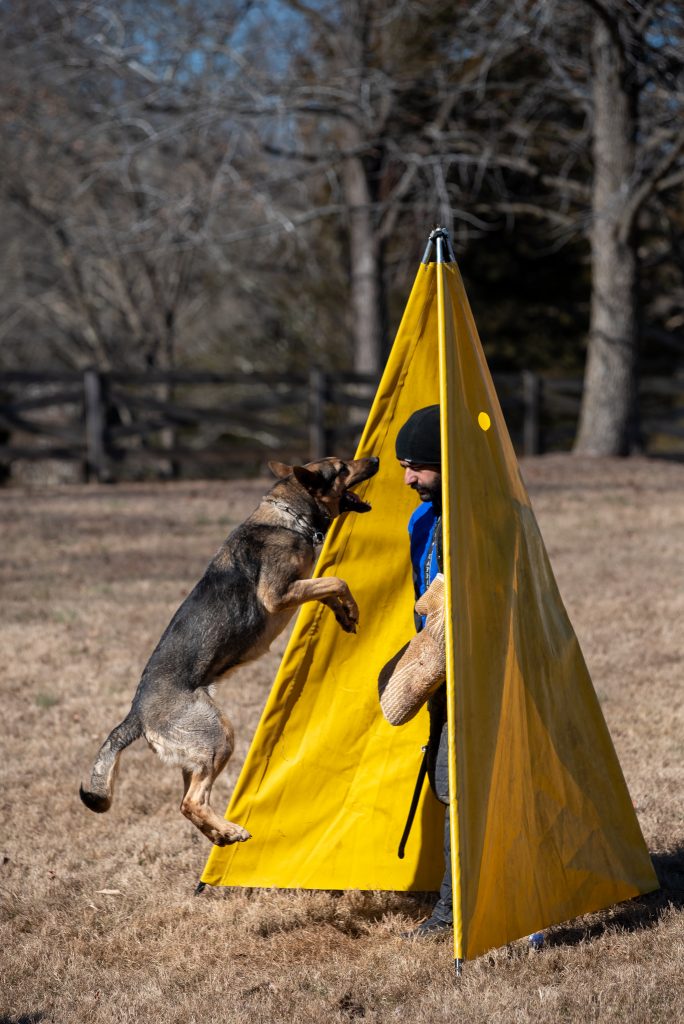
Learning and Growth:
Interacting with a diverse group of people within the dog sports community exposes you to various training philosophies, techniques, and perspectives. This continuous learning enhances your own training approach and contributes to your dog’s development. Additionally, constructive feedback from experienced individuals can pinpoint areas for improvement and guide you toward better results.
Sharing Triumphs and Challenges:
Dog sports involve highs and lows, successes and setbacks. Having a team and a community to celebrate victories and provide encouragement during tough times creates a sense of unity and shared achievement. Whether it’s mastering a new skill, achieving a personal best, or simply supporting each other through the ups and downs, the connections you forge make the journey richer.
Teamwork Beyond the Dog:
Teamwork and community-building extend beyond the dogs themselves. Organizing events, assisting with logistics, and offering encouragement to fellow competitors are all integral parts of the dog sports experience. By contributing to the community, you not only strengthen your bonds but also contribute to the growth and sustainability of the sport itself. While the relationship with your dog is at the core of dog sports, the collaborative efforts of a team and the support of a community elevate the experience. Surrounding yourself with knowledgeable, passionate individuals who share your enthusiasm can make the journey more fulfilling, educational, and ultimately successful. Whether you’re a novice or a seasoned competitor, the collective strength of a team and the sense of belonging in a community enriches every aspect of your dog sports journey.
VR: What do you consider as your major achievement so far?
AK: As proud as I am of breeding several VA dogs that can consistently perform in the courage test and placing nationally a few times with excellent kennel groups that come from a limited number of litters, breeding the same type of dogs consistently, that are sound in body and mind, that live many long happy years I’d say is my biggest achievement as a breeder. The goal of any breeder should be to create a sound population as close to the breed standard as possible. Exceptional dogs coming from a group of sound dogs will always do more for the breed than one spark here or there. Those are the dangerous ones as they will produce the omens of their litter mates in their children and the children of their children.
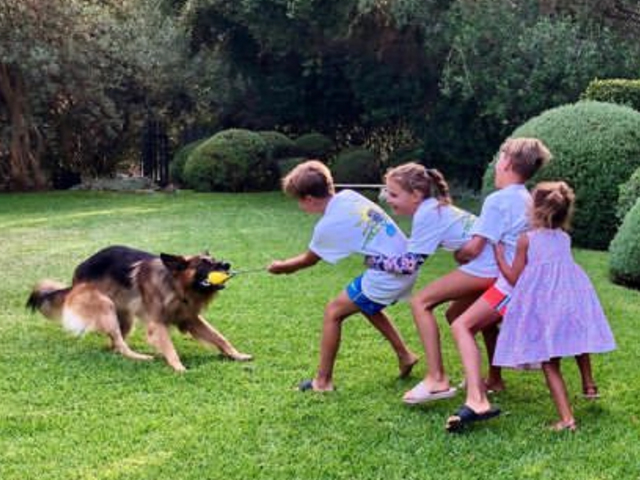
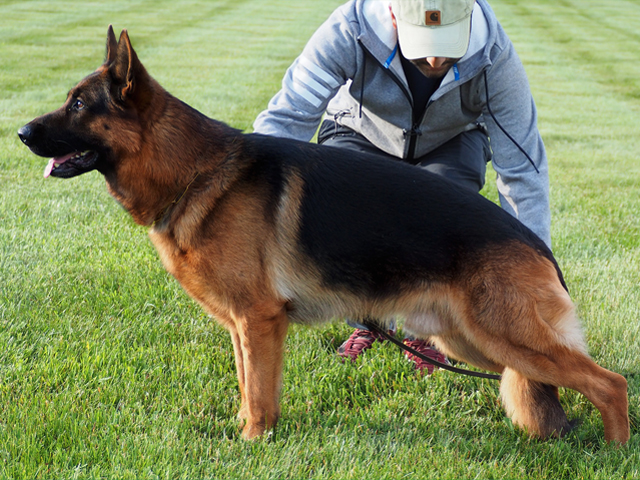
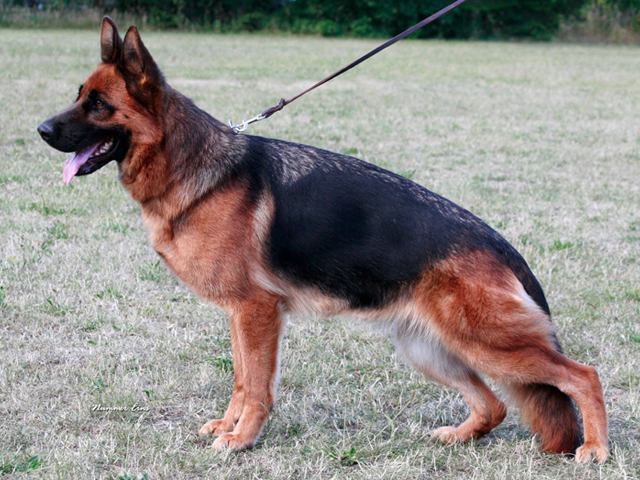
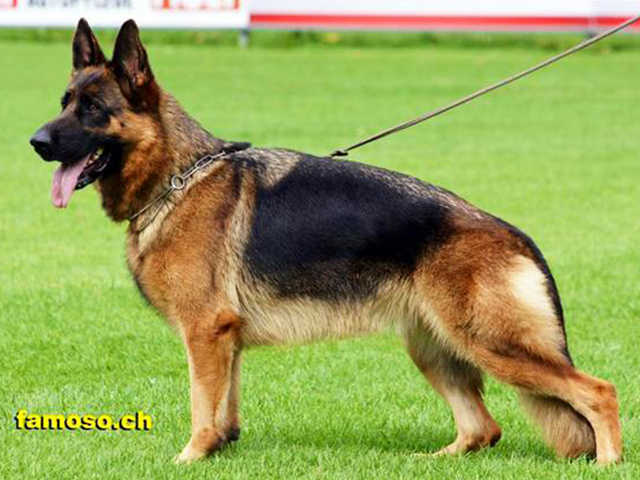
Above Left to Right: V1 O’Stryder v Nummer-Eins IPO3, FH1, VA Roma v Nummer-Eins IPO3, VA Vesta v Nummer-Eins IPO3
Below Left to Right: Canadian Young Sieger Kayos v Nummer-Eins IGP1, US Youth Siegerin Quiana v Nummer-Eins IPO1, US V1 Pistol v Nummer-Eins IPO2
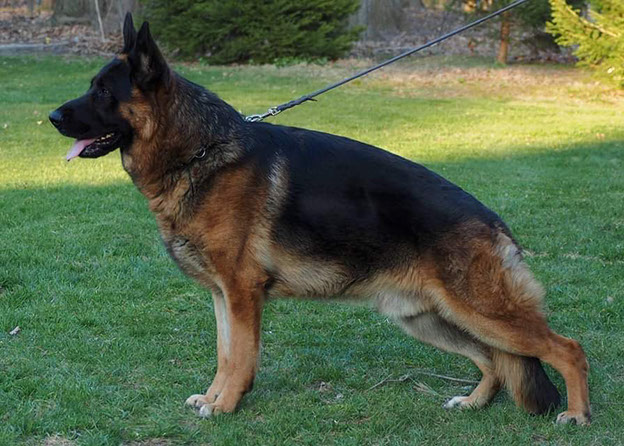
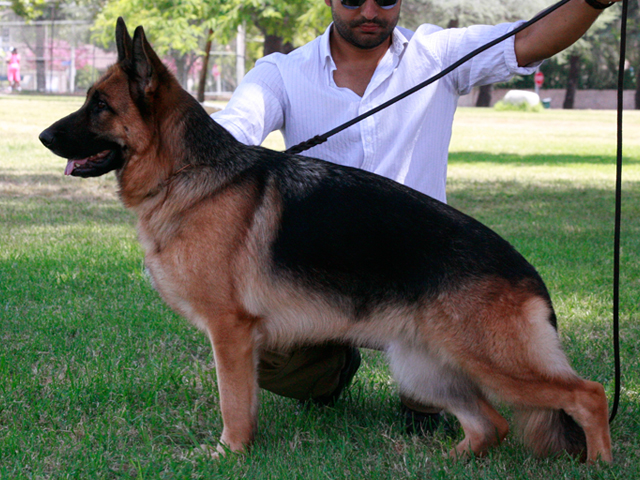
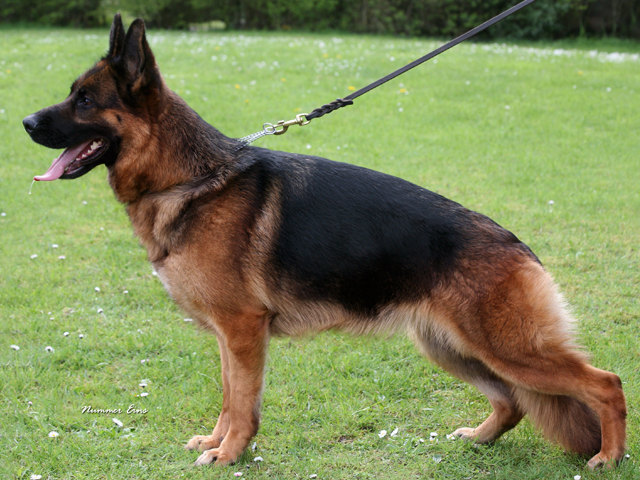
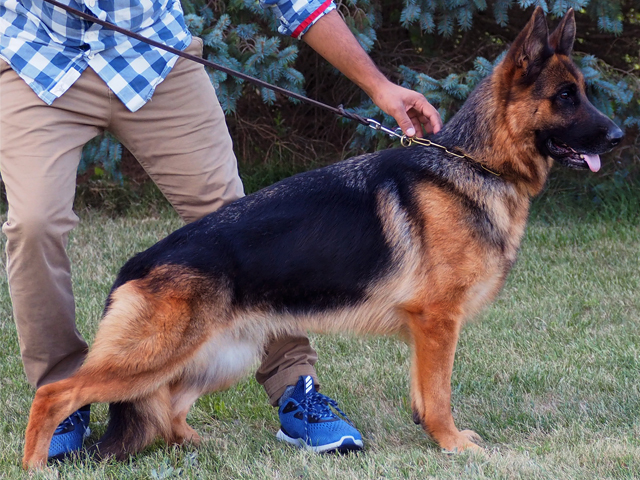
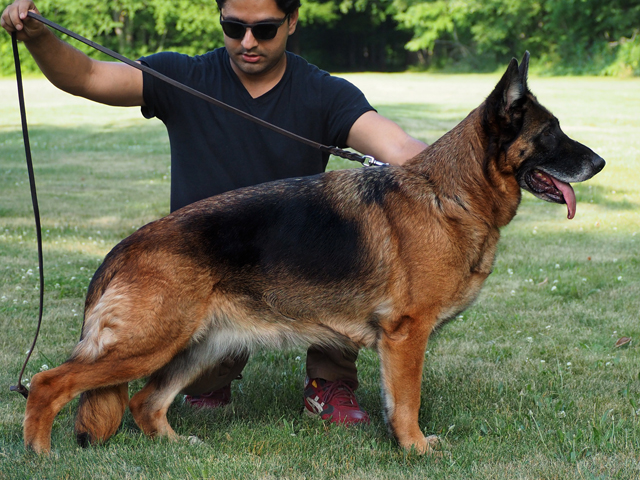
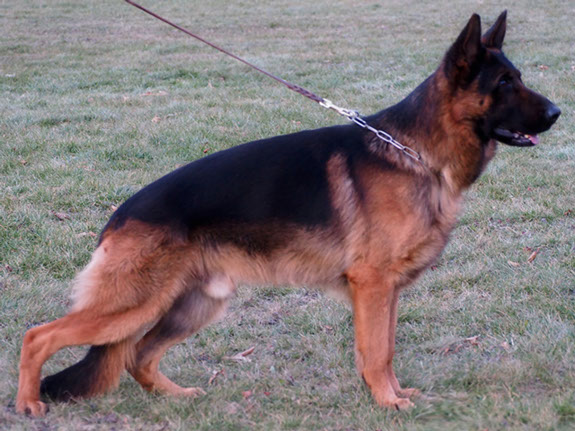
Above Left to Right: V1 Can Nala v Nummer-Eins IPO2, VA Vesper v Nummer-Eins IPO3, V1 Can Manolo v Nummer-Eins IPO3,
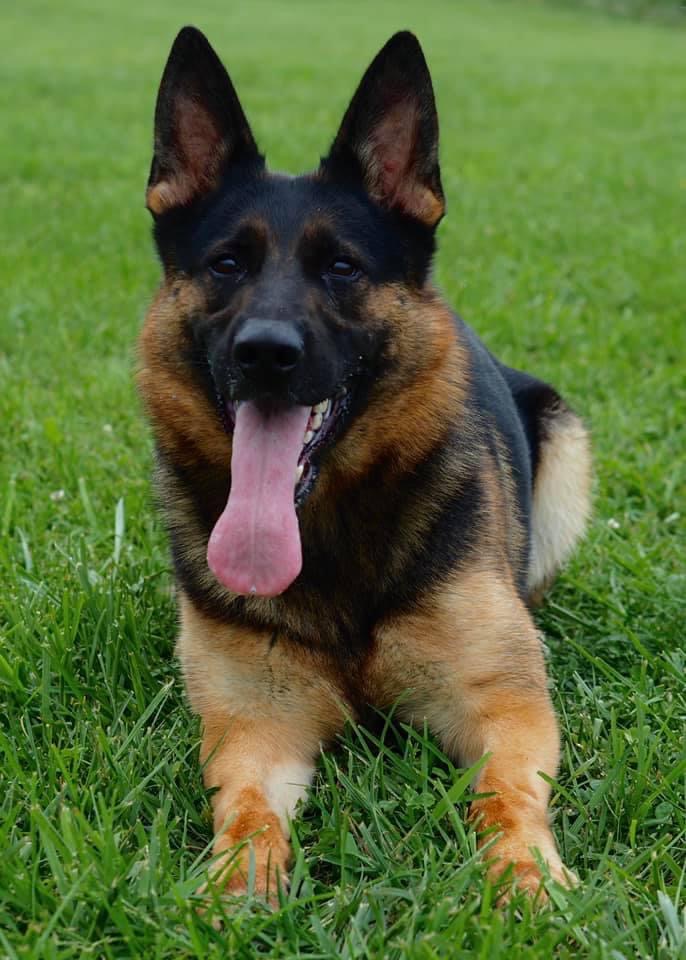
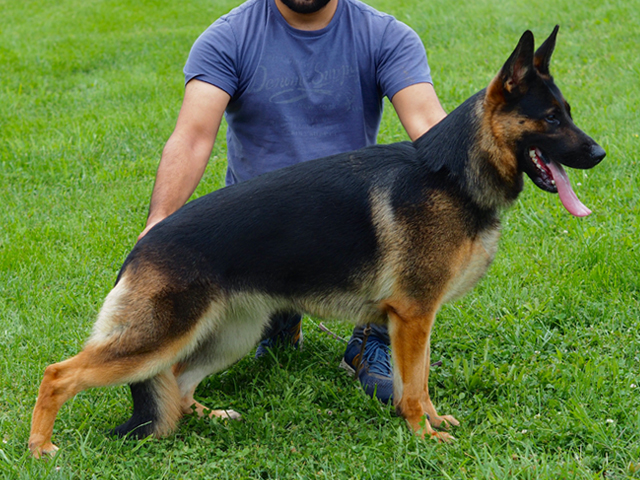
I also know that you did some breeding’s of your show dogs with popular working GSDs in America , what was the result like ? Did you face any criticism for the same?
Not because my dogs lacked drive, or structure or trainability, but because In my opinion, we are headed from a bottleneck to a dead end. So the gene pool must be opened, the existence of our breed depends on it.
The German Shepherd breed is in a unique place right now. It has become perhaps the most popular breed in the world, so there are dogs that suit the tastes of different enthusiasts across different fields and walks of life; ofcourse we humans are über competitive, we manipulate and control with both fringes, so exaggerations tend to occur in either direction. As dogs are bred closer to the chosen field of fancy, whether it’s some dogs from the show ring, or the breeding for high working/sporting
competition on the international stage or schutzhund/IPO/IGP.
This consequently and systematically led to the reduction of the number of ancestors in the genepool, with certain popular dogs appearing over and over in pedigrees from either side of the family tree.
Due to whatever reason, Germany started picking dogs from primarily one Y Chromosome haplogroup for over a decade. When I started seeing the lineup of VA dogs with the same grandfathers over and over again, I realized we were in trouble and immediately started looking for alternatives to breed into. At Present, you can trace all
the dogs competing in Germany to 5 dogs of the previous couple decades: Zamp, Vegas, Remo, Quenn and Ghandi. Literally every one of these males trace themselves back to ONE dog! All these dogs appear, reappear and re-reappear in a shuffle of a deck of cards, shallowing the genepool by repeatedly breeding onto these dogs in any number of combos, giving these programs the integrity of a house made of that very deck of cards.
The T litter Nummer-Eins was born from this consideration back in 2018, and Tabasco was held back to further broaden the blood and add an actual breadth to the genepool, making Nummer-Eins another pioneer in yet another dimension of foresight in breeding.
Tabasco has now had her first litter and this breeding includes 3 excellent families, two somewhat related and one of quite distant blood, that have been tested for multiple generations to produce healthy, mentally well surrounded dogs, going back to VA Vesper v Nummer-Eins, Motte v Suentelstein (mother of Stryder), and Jilnanah Talka Marda through Pia v Patiala. From this breeding I have Bijli von Nummer-Eins who shows great promise.
The other two breedings I did were with my male Lupin Dell’Alto Piano and my two outstanding females Nala and Nevada v Nummer-Eins, and they have produced dogs that are not only of sound anatomy but have excellent character, movement and have retained the family type.
There is great clarity in not being swayed by trends and keep trekking onwards to the summit, which here is to produce great german shepherds, not VA dogs, not championship podium dogs, but dogs that are correct representations of the standard, dogs that you can live with and bid on to work as a part of your life. As far as criticism by those who can’t do its concerned, I love this quote by Oscar Wilde, “Ridicule is the tribute paid to the genius by the mediocrities.”
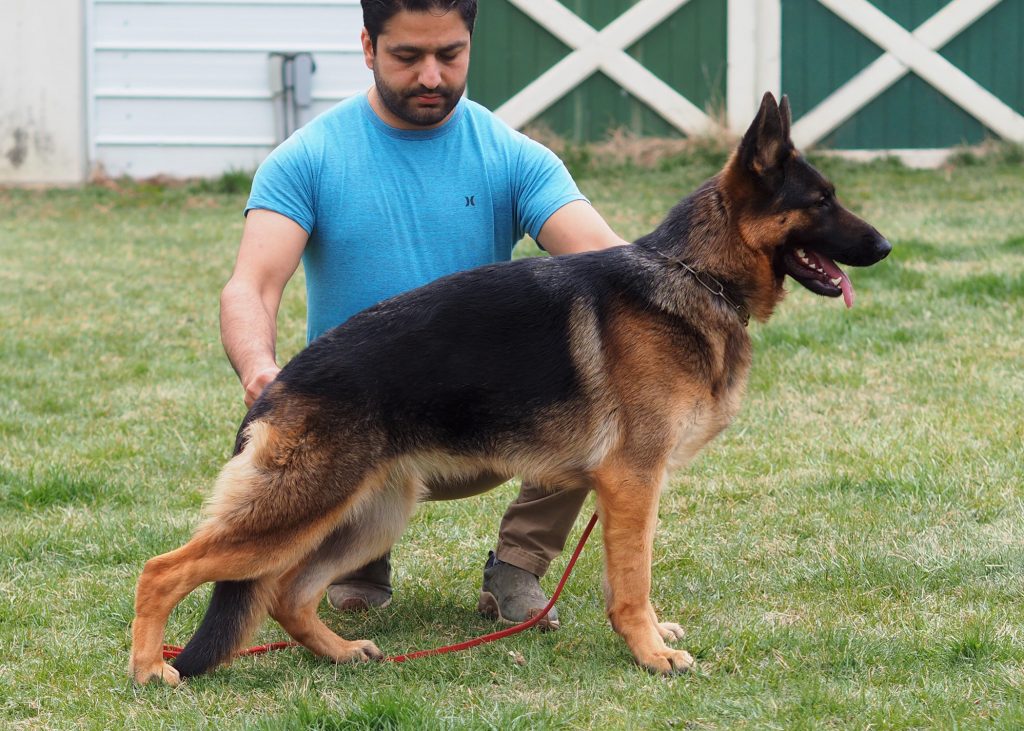
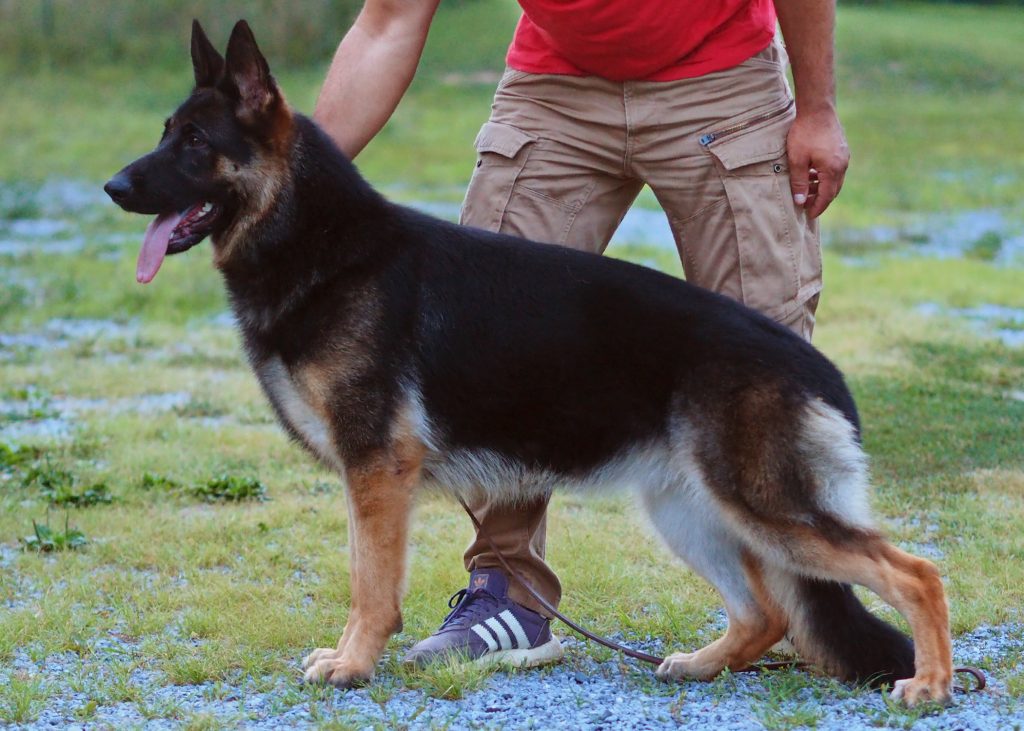
VR: considering the fact that India is still at the nascent stage of IGP what advise would you give to our readers?
AK: It’s crucial to approach the sport with the right mindset and preparation. Here are some pieces of advice for readers who are interested in getting involved in IGP:
● Educate Yourself: Begin by thoroughly researching and understanding the IGP sport. Learn about the three phases: tracking, obedience, and protection. Study the rules, guidelines, and expectations set by the governing bodies. Everything is available online, from rulebooks to video tutorials.
● Find Experienced Mentors: Seek out experienced trainers or mentors who have a strong background in IGP. Their guidance can be invaluable in learning the techniques, strategies, and nuances of each phase. Learning from those who have practical experience can significantly accelerate your progress. Look for people that have actually titled their dogs to teach you.
● Start with Basic Obedience: Before diving into IGP training, ensure your dog has a strong foundation in basic obedience commands. A well-trained dog will have an easier time transitioning to the more advanced commands required in IGP.
● Choose the Right Dog: While many breeds can participate in IGP, certain breeds are better suited due to their natural abilities and drives. German Shepherds, Belgian Malinois, and Dutch Shepherds are commonly seen in IGP due to their strong work ethic and versatility.
● Emphasize Proper Training Techniques: Focus on positive reinforcement-based training techniques that build a strong bond of trust and understanding between you and your dog. Harsh methods can be counterproductive and harm the dog’s enthusiasm for training.
● Prioritize Socialization: Socialize your dog extensively from a young age. Exposure to various environments, people, and animals helps develop a confident and well-adjusted dog, which is essential for success in the sport.
● Work on Each Phase Separately: Train each phase—tracking, obedience, and protection—individually before combining them. Mastering each phase before moving on ensures a solid foundation and prevents overwhelming the dog.
● Patience and Consistency: IGP requires time, patience, and consistency. Progress may be slow at times, but consistent training efforts will yield better results in the long run.
● Set Realistic Goals: Set achievable goals for both you and your dog. Celebrate small victories along the way to keep motivation high.
● Stay Humble and Open to Learning: IGP is a complex and evolving sport. Approach it with humility and a willingness to learn from every experience, whether successes or setbacks.
● Respect the Sport’s Ethos: Remember that IGP is about assessing a dog’s working abilities. Strive to maintain the integrity of the sport by focusing on your dog’s development rather than pursuing titles solely for prestige.
● Enjoy the Journey: While IGP is a serious sport, remember to have fun and enjoy the journey with your dog. The strong bond you develop and the shared experiences are what truly matter.
As India’s IGP community grows, a commitment to responsible training, sportsmanship, and the well-being of your dog will contribute to the sport’s development and success in the country.
VR: Did you also a have a mentor while you were pursuing your passion ? What is the role of a mentor ? How important is the role of seniors and mentors ?
AK: I was not so fortunate to have a real mentor as I started in dogsport. There wasn’t much camaraderie where I was in the North Indian circuit and everyone was chasing the next import (seems like it hasn’t changed much). I was hungry to learn from whoever I could engage with. Since I started very early (in my early teens), I did not have money to buy expensive dogs or to just hire people to train and present my dogs. This has turned out to be my great advantage in life, not being handed anything. I learnt from afar by watching the winners, and also developed my taste in dogs from what I felt fit the blue print given to us by the breed standards.
I met a gentleman by the name of Mr. Sanjit Mohanty, (who I think your audience is familiar with) as a teenager, and used to have many discussions with him about the breed standard, debate him on his ideas and I feel that these talks helped me form my idea of the German Shepherd independently. I am thankful that he took the time to engage with me and indulge in conversation about my ideas, and gave me the respect to disagree with him.
Later on in life, in my early 20s, I started speaking regularly with Mr. Ajay Singh (von Patiala), who I felt shared the same passion as I did for the breed, and went through tribulations and faced similar prejudices as he got established in the United States. To this day we speak almost everyday and discuss our beloved breed, training methods, future plans, bloodlines and life.
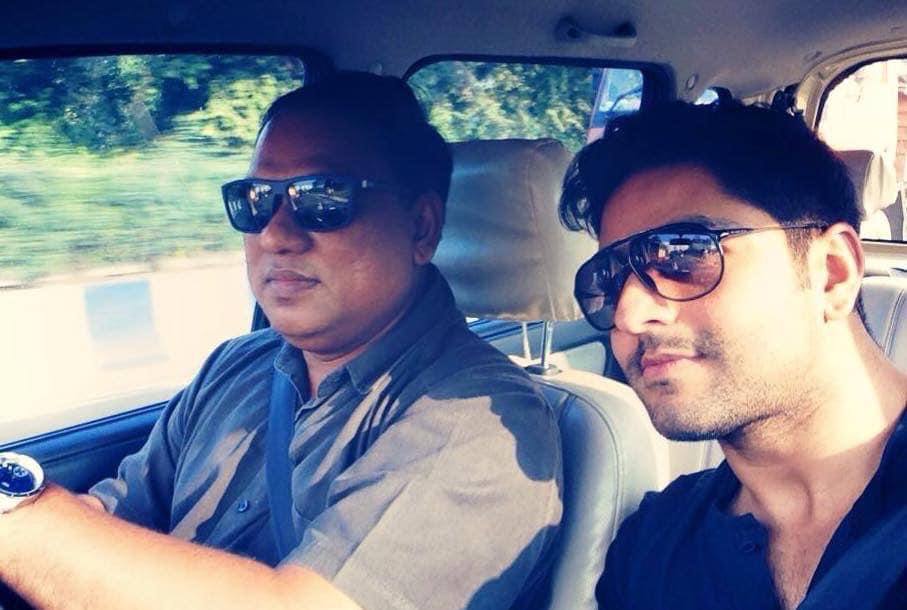
Above: Sanjit Mohanty (Left) with Abhai (Right)
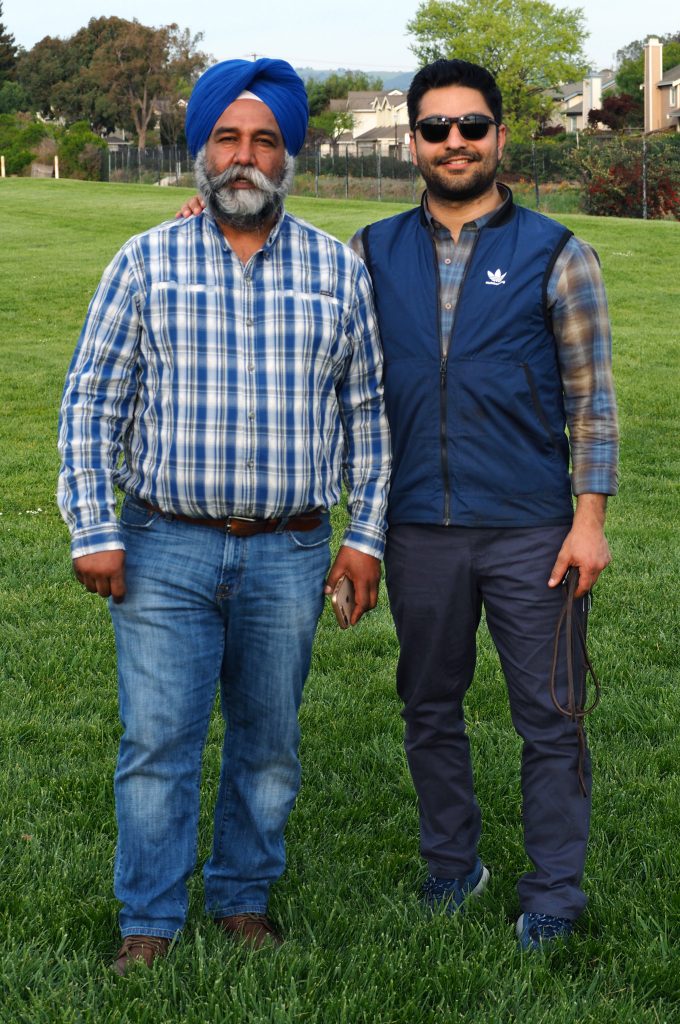
VR: Describe the correct back of the German Shepherd for our readers. The common misconception is that in the show line the young pups do not have a firm back and legs, and they stabilize later. Are they actually unstable while growing?
AK: The Overline or Top Line is defined clearly in the Breed Standard in the following excerpt: “The Overline runs from the base of the neck via the high, long withers and via the straight back towards the slightly sloping croup, without visible interruption. The back is moderately long, firm, strong and well-muscled. The loin is broad, short, strongly developed and well-muscled. The croup should be long and slightly sloping (approx 23° to the horizontal) and the overline should merge into the base of the tail without interruption. ”
Let’s delve into the details of the parts of the canine spine and their role in movement, as well as the relationship between the back and the transmission of hind thrust to the front reach.
- Thoracic Spine: The thoracic spine is located in the chest area and consists of twelve vertebrae. These vertebrae connect to the ribs, forming the ribcage. The thoracic spine plays a crucial role in protecting the organs within the chest, such as the heart and lungs. Additionally, it provides attachment points for muscles involved in respiration, posture, and stabilizing the trunk. The thoracic spine has limited flexibility, which helps maintain stability during movement.
- Lumbar Spine: The lumbar spine is situated in the lower back region and is composed of five vertebrae. This portion of the spine bears the majority of the body’s weight and is subject to significant stress during movement. The lumbar spine allows for more flexibility compared to the thoracic spine, enabling actions such as bending, twisting, and jumping. The muscles and ligaments surrounding the lumbar spine provide support and stability during these activities.
- Sacral Spine: The sacral spine refers to the section of the spine that connects the lumbar spine to the pelvis. It consists of fused vertebrae known as the sacrum. The sacral spine plays a vital role in transmitting forces generated by the hind limbs to the rest of the body. It forms a strong connection between the hindquarters and the back, allowing efficient transfer of propulsion to the front limbs during movement. Efficient motion and longevity in a dog’s career are closely tied to the proper functioning and alignment of the spine. Exaggerations in the spine, such as excessive curvature or deviations from the natural structure, can be detrimental to a dog’s movement and overall health.
- Transmission of Hind Thrust: The hindquarters of a dog generate the primary propulsive force for movement. The transmission of this thrust to the front reach is facilitated through the spine. A well-aligned and balanced spine efficiently transfers the energy from the hind limbs to the front limbs, resulting in coordinated and effective movement. Exaggerations or abnormalities in the spine can disrupt this transmission, leading to inefficient movement, reduced power, and potential strain on various parts of the body.
- Efficient Motion: A properly functioning spine with balanced curves allows for optimal range of motion and flexibility. It enables the dog to execute movements with ease, fluidity, and precision. Exaggerations in the spine can restrict mobility, limit the dog’s ability to perform certain tasks, and increase the risk of injuries.
- Longevity: Exaggerations in the spine can lead to structural imbalances and increased stress on certain areas of the body. Over time, this can contribute to wear and tear, joint problems, and chronic pain. Dogs with exaggerated spines may be prone to musculoskeletal issues, impacting their long-term well-being and potentially shortening their career or active lifestyle.
The back is pivotal to a dog’s movement and overall functionality. Proper alignment and balanced structure of the spine are crucial for efficient motion, transmission of hind thrust, and long-term health. Exaggerations in the spine can disrupt these factors, negatively impacting the dog’s performance and longevity.
Structural balance is of utmost importance to any sound machinery’s function and longevity. Our German Shepherds are no different. When we don’t pay attention to these minutia and devote energy on filigree of trends and latest winning fashions, then its the breed that loses.
VR: Please elaborate on correct German Shepherd movement.
AK: Think about what makes a German Shepherd a German Shepherd. Realize what the purpose of the breed was first and foremost, and if the iteration that catches your fancy manifests that aspiration ideal in a clear fashion. A knowledge of the breed standard and the knowledge of basic kinesiology doesn’t hurt either.
Think of a bicycle. It needs two wheels, ideally of the same size, larger in proportion to the bike’s frame, to function in normal, everyday use. The amount of force exerted at the pedal, to propel the bike forward, is a constant when we need to go at a certain speed, if we were to change the size of one wheel, we will have to exert more force to move the same distance as the smaller wheel will have to rotate more times to cover the said distance which was covered with less pressure exerted when the bike was equipped with a larger wheel. Let’s look at the chain of the bike, which links to two sprockets together. The chain has a certain amount of tension on it at all times. If it’s too tight, it will snap, also, if it’s too loose, it’ll just come off, nullifying the purpose of your bike, which is motion. Now, consider the frame of that very bike; if the frame was not rigid, but like a slinky, imagine how much effort it would take to just keep the bike together, forget riding it or moving it forward.
Now, think about your German Shepherd’s frame like that bike, the wheels replaced by legs, the chain replaced with the dogs ligaments and tendons and the bike’s frame replaced by the dog’s skeleton and musculature. Now the proportions start making sense, don’t they? Longer legs to propel the body and the muscles and tendons holding the frame in place, keeping it secure as the dog maneuvers around the sheep, retrieves a wooden dumbbell, jumps a fence or a hurdle, or just plainly and efficiently moving in a linear fashion.
What we are seeking in our dogs, anatomically or mentally is balance, We are not searching for extremes in the GSD. A well balanced working dog that can fit in a family, has control over its emotions, and can perform tasks when the situation arises is the right type of character in this magnificent breed.
Balance in movement is paramount when we speak of untiring effortlessness. Just the push from your dog’s innate drive to propel forward if it has an over angulated stifle will not help the case of longevity. Sooner or later it’ll catch up and hamper long term mobility. There might be a correlation to why we don’t see these winning dogs with exaggerated rear ends in their later years. Excessive under reach must also be addressed: motion in plantigrade vs digitigrade rear motion, flattened metacarpals and metatarsals that can’t leave the ground due to excessive angulation and lack of overall firmness.
Straightness of limbs: Not just rear but also the front is equally important. Factors to consider would be not only the height to depth proportions but also the lay of elbows, straightens of the forelegs, firmness of pasterns, and shape of feet. A wide barrel chest and a narrow chest both would cause problems in efficient motion, impeding fluid movement, making it less cost effective in the economy of kinetics. We have to actively select for dogs with these traits since not paying heed to the front legs which are the load bearing limbs, can and will cause injuries, impeding the affected dogs for life.
The GSD is a trotting breed by design, meant to tend to flock animals. The most distance covered with the least amount of effort exerted is the desirable action, as prescribed in the standard, and to realize this, a sufficiently long upper arm with a correctly angled shoulder is the forehand setup of choice.
A long, flowing croup is nothing without a forequarter that matches it and similarly a perfectly angled forehand is futile when paired with a curved spine or a steeply angled croup. The same rear that creates the illusion of a flashy side gait when moving at an artificially hight speed on a taut line with a handler in tights, is actually hampering the dogs agility, as it tries to turn quickly and also prevents walking efficiently at normal speeds in real life situations. The German Shepherd movement shouldn’t be lauded as a circus act, but as an efficient, purposeful and deliberate call to action, whatever might have been asked of it.
An elephant riding a tricycle in a circus is a spectacle, doesn’t make it right.
VR: There is a trend towards larger and larger heads these days. Is that correct? Would you please elaborate on what a correct German Shepherd head should look like?
Let’s go back to the breed standard again.
“The head is wedge-shaped, and in proportion to the body size (length about 40 % at the height at the withers), without being plump or too elongated, dry in the overall appearance and moderately broad between the ears. Seen from the front and side, the forehead is only slightly arched and without any or with only a slightly indicated middle furrow. The ratio from the cranial region to the facial region is 50 % to 50 %. The width of the cranial region more or less corresponds to the length of the cranial region. The cranial region (seen from above) tapers evenly towards the nasal bridge with gradually sloping, not sharply depicted stop in the wedge-shaped facial region (foreface) of the head. Upper and lower jaws are powerfully developed. The nasal dorsum is straight, any dip or bulge is undesirable. The lips are taut, close well and are of dark coloring.”
The German Shepherd must have by design a lupoid head, which is mesocephalic in nature. The overly large heads, with wrinkles on the forehead which rounded, and hence not parallel to the muzzle is atypical of the breed and should not be encouraged. To maintain the correct expression, the dog must have almond shaped eyes with tight lids. Often with these over developed heads we see droopy eyelids, large ears and loose flews, all of which are uncharacteristic of a German Shepherd Dog and in my opinion it should be penalized to a greater extent.
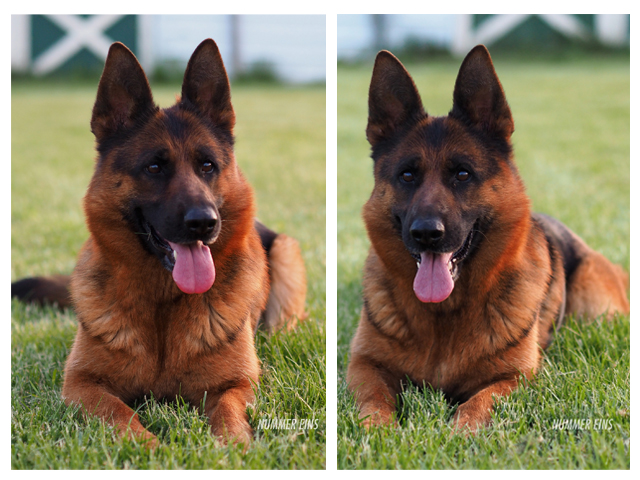
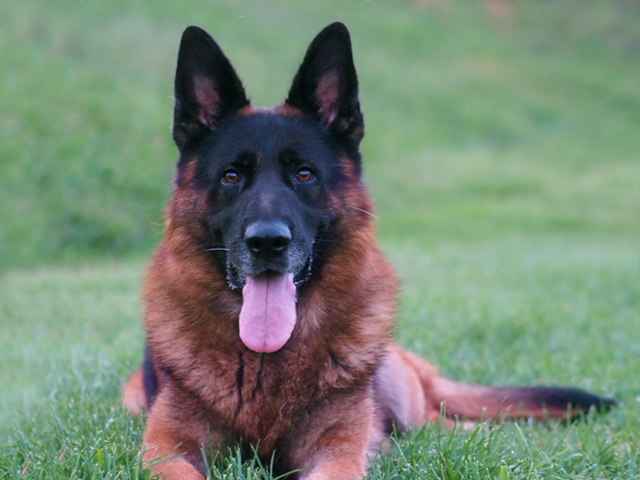
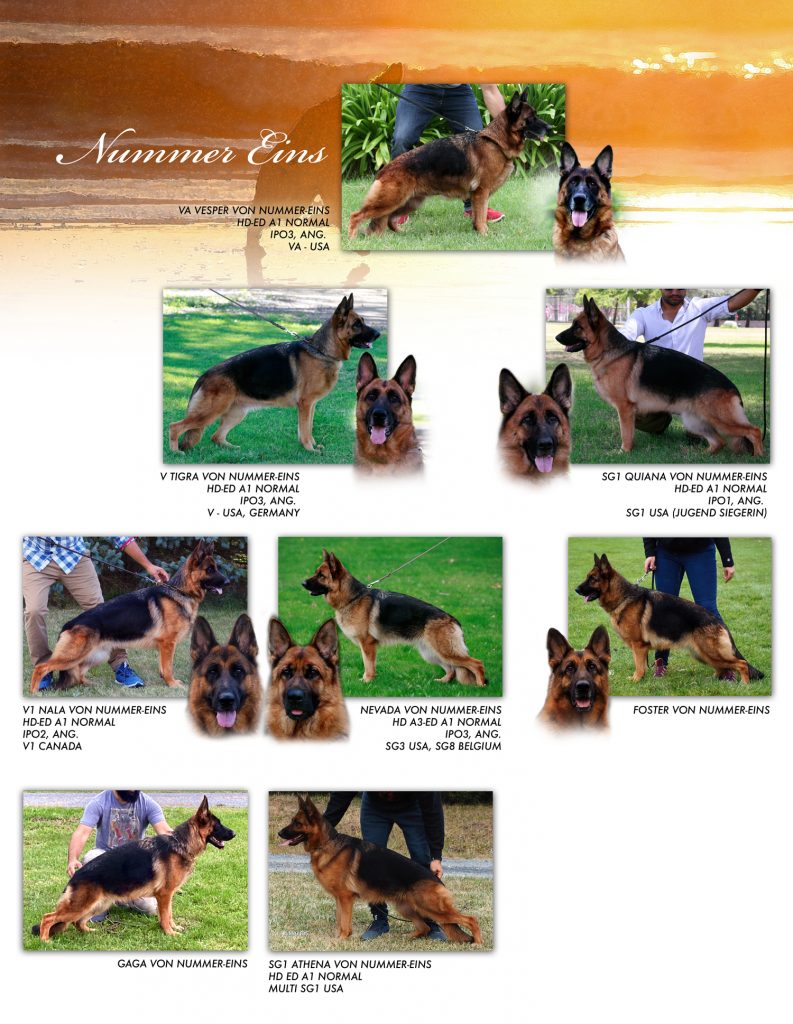
VR: The German shepherd is considered one of the most challenging breeds and one of the most difficult to breed with consistency what according to you is a corner stone of any kennel? what should be the aim of a breeder who wants to attain success in breeding GSD’s
AK: A strong and dominant mother line forms the bedrock of a successful breeding program. This refers to a lineage of female dogs that consistently exhibit strong and dominant traits, which are then passed down to their offspring. Such a mother line is pivotal for maintaining consistent qualities, health, and characteristics across generations of a breed.
Consistency: When a breeding program is built around a strong mother line, breeders can anticipate certain traits, behaviors, and qualities in the offspring. This consistency helps maintain the breed’s desired characteristics over time.
Temperament and Behavior: The temperament and behavior of a mother dog significantly influence the behavior of her puppies. By selecting and breeding from
females with stable, desirable temperaments, breeders can contribute to producing puppies with good behavior and trainability.
Genetic Diversity: Maintaining a diverse gene pool within the mother line helps prevent the accumulation of genetic issues caused by inbreeding. A diverse mother line contributes to overall genetic health and reduces the risk of hereditary disorders. Preservation of Breed Type: Mother lines that consistently produce dogs that adhere to the breed standard ensure the preservation of the breed’s physical appearance, structure, and other defining traits within the type of dogs chosen.
VR: How many Dogs have you used in your breeding program which were not bred by you? What do you look for in a dog before you select him in your breeding program or when you want to keep a pup for yourself?
AK: When I choose a dog for my breeding program, I take into account my personal preferences and the goals I have in mind. My aim is always to pick a dog that either complements the existing dogs in my breeding stock or possesses specific qualities I want to introduce into my breeding lines.
Until recently, I had incorporated several dogs into my program that were not bred by me. Among the key attributes I look for in these dogs, apart from ensuring they have the correct structure and secondary sex characteristics, are their food drive, absence of gut health issues, strong hunt drive, and significant breeding drive. These factors are not only linked to the dogs’ innate genetic traits but also their overall health and well-being. It’s interesting to note that the top dogs that are prominently featured worldwide often share a particular structure and are usually related. I became concerned about this when I bred to the VA1 and VA3 males in Germany, which was somewhat unusual for me because I typically don’t go for top-winning dogs. However, I discovered that the resulting puppies were very much like their fathers and didn’t align with the direction I wanted for my breeding program.
This realization led me to think outside the box and make unconventional choices. I decided to breed to Ucon v Patiala and later acquired my current competition male, Lupin dell’Altopiano. These decisions not only brought much-needed diversity into the bloodlines but also added their exceptional qualities to my existing dogs, all while allowing me to maintain the type I desired. I take pride in these choices, even though they may have seemed unconventional to others. Sometimes, people may label you as a “working person” for going against the grain, but isn’t that the essence of the breeding journey?
You see, pedigrees aren’t as linear as we’ve been led to believe; they’re more like an intricate web of connections. This is especially true when dealing with purebred dogs and further narrowing it down to a specific breed and its various types. Over decades, this can become a self-defeating cycle where we constantly look at others and try to replicate their methods without asking ourselves the tough questions. However, once we take a step back and engage in self-reflection, the path becomes clear, defined by the breed standard itself.
VR : How many Litters have you had till date ? how many times did you want to retain a pup from the said breeding and how many times you could ?
This is my second go through the alphabet, that means I have bred 30 plus litters in the last two and a half decades.
The purpose of carefully selected breeding is to preserve and enhance the qualities of the German Shepherd Dog for future generations. This process involves the deliberate pairing of dogs that possess desirable traits, both in terms of physical characteristics and temperament, to produce puppies that meet or exceed breed standards. Here’s why retaining a dog through careful breeding is essential for the future of the breed:
● Preservation of Breed Traits: Breeding allows breeders to maintain the unique and distinctive traits of a specific breed. Whether it’s the appearance, size, coat type, temperament or drive, breeders should aim to ensure that these characteristics remain consistent over time.
● Health Improvement: Responsible breeding practices also focus on the health of the breed. By selecting dogs with good genetics and screening for hereditary diseases, breeders must work to reduce the risk of health issues within the breed.
● Temperament and Behavior: Breeding for temperament is crucial to ensure that dogs within the breed maintain the desired behavior and temperament traits. This is especially important for breeds that have specific roles or functions, especially important in a breed as versatile as the German Shepherd Dog.
● Genetic Diversity: Maintaining genetic diversity within a breed is vital to prevent inbreeding and the associated health problems. Careful selection of breeding pairs can help introduce new genetic material and reduce the risk of genetic bottlenecks and prevent long term damage to the breed.
● Continuity of Bloodlines: Retaining certain bloodlines through selective breeding allows breeders to build upon the strengths of their own breeding programs. This can lead to the development of exceptional dogs that contribute positively to the breed’s legacy. I am in the 6th generation of my breeding line, and I am quite proud of how this family has been established through the years and produced healthy dogs that are distinctly the Nummer-Eins type.
However, it’s important to note that as a responsible breeder, one must prioritize the welfare of the dogs involved. Ethical breeding does not engage in indiscriminate or backyard breeding. We must always prioritize the health and well-being of our breeding dogs and puppies and adhere to established breeding standards and guidelines to promote the betterment of the breed while ensuring that the dogs in their care lead happy and healthy lives.
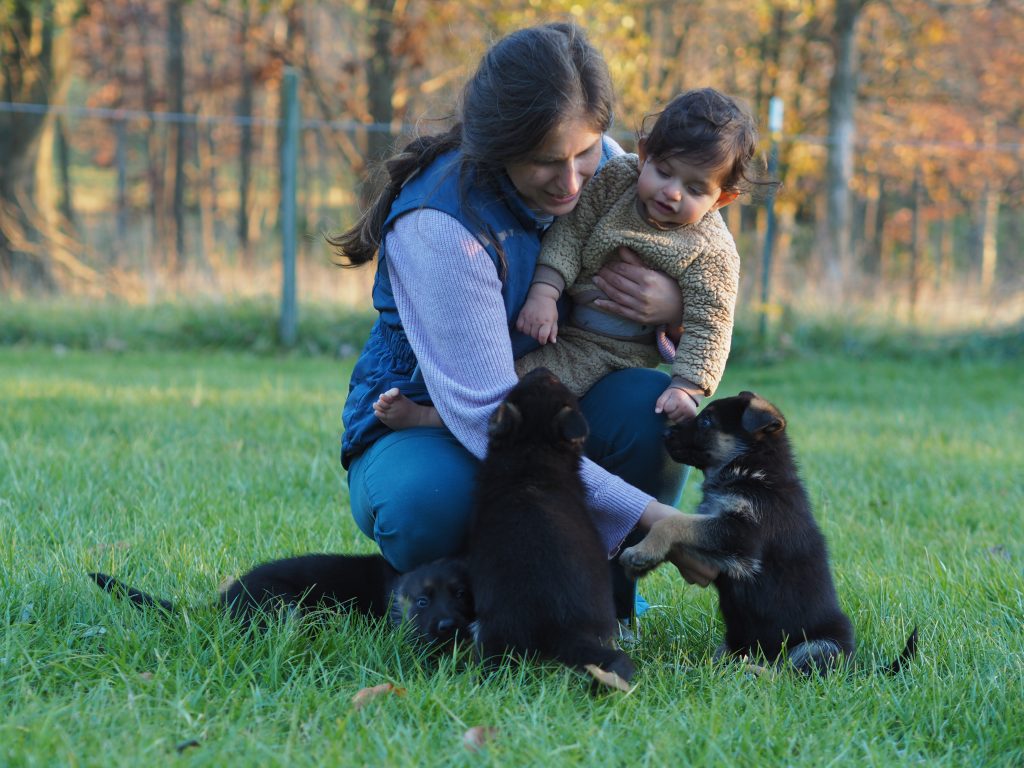
Below: Aria, a daughter of Lupin x Nevada.
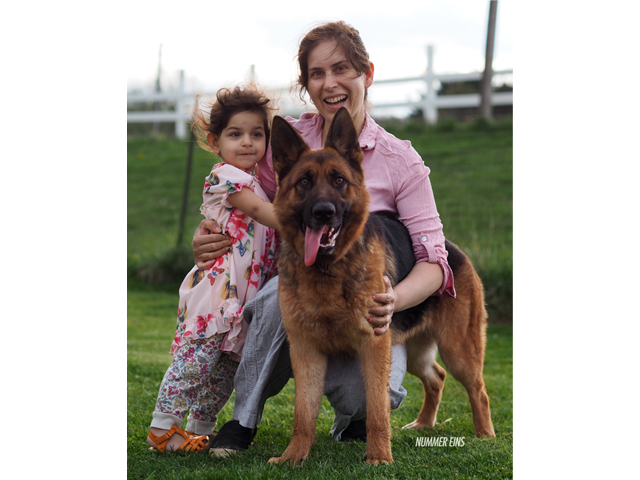
VR: Which dog/ dogs according to you have been the most influential GSDs which have made a significant contribution to the breed’s history in Germany and across the globe? Who is your favorite amongst the current dogs?
AK: From the High Breeding lines or Show lines as they’re called, currently we have the Quanto Wienerau family that has clearly established itself as the dominant family due to the placement of several males from the line in the top group for multiple years, known for their substantial bone structure, the attractive red black color and thick coats. Naturally, the dogs that came from this family have established themselves as the most
dominant producers with the maximum number of children born, as they find favor with breeders looking to breed with high placing dogs. From this family, Zamp v Thermodos in my opinion has been the best as far as physical attributes are concerned. This dog was years ahead of his time, and single handedly changed the forehands of the dogs worldwide for the better. The three other influential males that feature this line are Vegas Du Haut Mansard, Remo Fichtenschlag and Quenn Löher Weg.
The other dominant breeding was the Serbian breeding “O” Radhaus litter, with several sons placing in the top group in Germany, and then from them, came future siegers down the line. The are still present fairly regularly in the pedigrees of several VA males and females in Germany and elsewhere.
When we look at the other side of the isle at Leistungzucht or the Working Lines, Mink vom Haus Wittfeld and Fero vom Zeuterner Himmelreich enjoyed great popularity in bygone eras. Another prominent male in this lineage was Grief zum Lahntal. Notably, Troll vom Bosennachbarschaft (with another popular brother Timmy), with an interesting lineage tied to Mutz Pleztierfarm (whom they were line bred on), also played a significant role. These dogs can be regarded as the cornerstones of the working line German Shepherd breed.
In recent decades, we’ve witnessed the emergence of notable figures like Javir Talka Marda (and his sister Jilnanah Talka Marda), and today, the H litter Wolfsheim (Henrik, Horax and Henry, with these three brothers not only making it to the world championship level but actually all three placing in the top 5) stand as the prominent figures, alongside a select few others, within the working line German Shepherd community. More importantly, you see several successful sons and grandchildren from these dogs competing at the highest level in their chosen field, shows you the breeding power of these families.
VR: Can you name some of your favorite GSDs owned or bred by you and tell us why you feel they are special? In what way do you feel they have contributed to your breeding program or the breed?
AK: I would start with VA Vesper von Nummer-Eins, the matriarch of von Nummer-Eins. This is a female that gave me so much. She was the first dog that I did all the training from a puppy to the IPO3 level, and was also my first VA dog from my own breeding, along with her sister VA Vesta v Nummer-Eins. Vesper was not only a beautiful and temperamentful dog but also an unbelievable producer. She produced the American Youth Siegerin in 2014 SG1 Quinana v Nummer-Eins, the Canadian Young Sieger in 2017 Kayos v Nummer-Eins (who has established himself as a very prepotent sire) and was the grandmother of several winners in the years to come. Vesta also was an outstanding producer, producing the excellent V1 Pistol v Nummer-Eins and then the American and Canadian Long Hair VA1 Roz, who’s father typical son is also now a VA in the USA.
The next has to be O’Stryder v Nummer-Eins, another male from my breeding that I titled to IGP3 and FH1. This was a dog that would shut up the critique of high breeding line dogs not having enough working drive and ethic. This male had power and speed, in protection with convincing guarding, was a breeze to teach obedience, a very quick learner and efficient jumper, and a natural tracker. I really enjoyed competing with him
all over the US, entering trials on a whim and getting a high in trial for both his IGP1 and his IGP3.
The next would have to be Tabasco von Nummer-Eins as she represents that bridge to the other side, and now producing children which maintain the same family type, but have the extra zest she brought to the table.
The final would be VA Roma von Nummer-Eins, another VA female from my breeding who was a standout since she was a puppy, not just with her beautiful type, but also her character that she passes on to her children.
These dogs will always have a special place in my heart because not only are they exceptional dogs themselves, but have gone to produce exceptional dogs that are well knit, driven and biddable.
VR: What are your favourite bloodlines? Have you incorporated them in your breeding program?
AK: The von Nummer-Eins slogan is “Where resilience and grandeur are necessary”, and befittingly, I enjoy striking dogs that are mentally strong, and physically robust: the quintessential German Shepherds. I like several bloodlines for things they bring to the table, and I have tried to always find families with a history of several exceptional dogs, to include into my motherline. Bobo v Arlett CA was one such dog. He was an unknown dog in Canada that no one knew or cared about, but, in my opinion, he was one of the best males in the world at the time. He went on to become the American Vice Sieger VA2, the Canadian Sieger VA1 and V29 in Germany. He is the father of three of my home bred VA females.
The next dog I enjoyed spending time with was Mac von der Kine, He was a BSP competitor, a large and mentally strong, male with a very good body. I did not have the right female for him at the time, but later on had the chance to breed with his best son Ucon v Patiala, another male I liked very much, who has a strong and stable motherline. The third line that I thought was fascinating was the H-Litter Wolfsheim, and I happen to own a fabulous son of Henrik Wolfsheim, Lupin, who himself has turned out to be a great producer.
VA Esko von Daenischen Hof, who was known to be an excellent producer of hips, and can be found in the motherline of many top dogs through his several excellent daughters; VA1 Zamp v. Thermodos who was a grandson of Esko through his mother, who took over that mantle and V6 BSZS Idol v. Holtkämper Hof (son of an excellent Ginga v. Kristallsee), I appreciated these males for their physical attributes: Esko and Zamp for their near perfect forehands and height to length proportions, Idol for his dry and firm built and body type. Two other dogs I find influential are Amigo v Belgier (Going back to F-litter Herschel and Uran v Wildstiegerland) You can find him in almost all showline dogs that have a good character and pronounced drives. The last dog I would mention here would be Nero v Noebachtal (His motherline is bred similarly to Amigo) and was the first male that caught my eye with his outstanding presence and expression. There was no other like him at the time when I was forming my opinion of the type of dogs I want to own and breed. With Kayos, Stryder, Manolo, Quest and now with Himmat, you can see that I have been able to combine these lines and create a blueprint that produces anatomically balanced, driven males, with outstanding pigment and kennel type, which is not very easy to do.
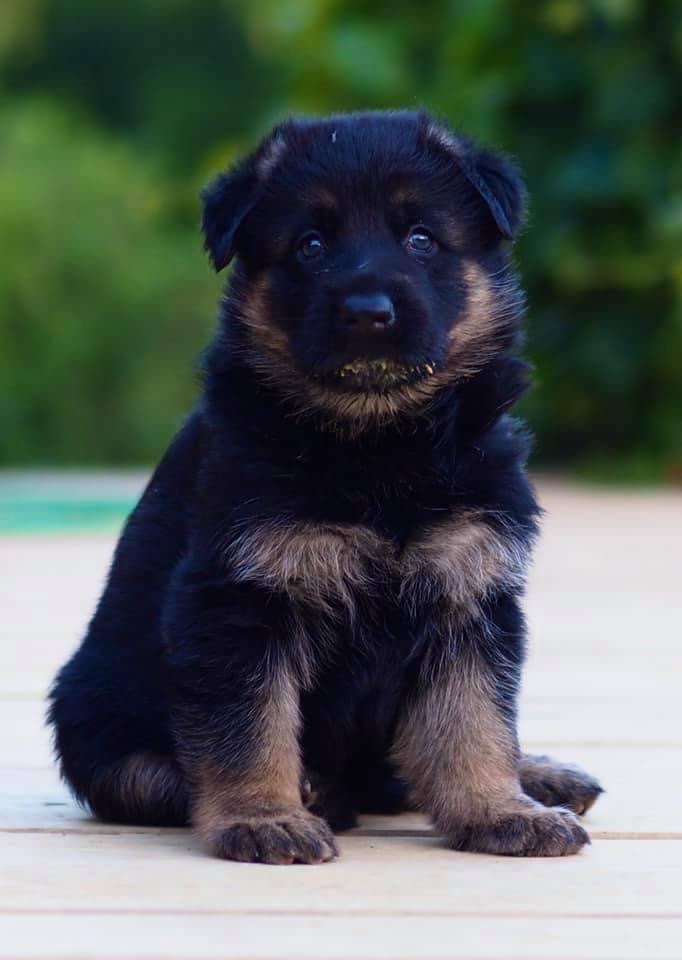
VR: GSD puppies do tend to undergo a lot of changes while growing and may end up looking completely different from what was expected. Once you make your pick, how often do they grow up to look exactly like what you envisioned them to be? And also, sometimes despite doing everything health issues crop in has this ever happened to you?
AK: Breeding German Shepherd puppies is an intricate and dynamic process. It’s true that GSD puppies can undergo significant changes as they grow, and their final appearance may not always align perfectly with our initial expectations. The journey from puppyhood to adulthood involves various factors, including genetics, nutrition, and environmental influences, all of which can influence their development.
In my experience as a breeder, I’ve found that while I may have a vision for how a puppy will turn out based on the parents’ traits and pedigrees, it’s not uncommon for some puppies to surprise me with their growth and development. Genetics can be unpredictable, and even with careful planning, variations in coat color, structure, and size can occur.
Furthermore, despite taking every precaution to ensure the health and well-being of my puppies, health issues can still arise. Responsible breeders conduct health screenings and genetic testing, but no breeder can guarantee that every puppy will be completely free from health concerns throughout their lives. Some health issues may manifest later in life, and it’s essential for new puppy owners to stay vigilant, provide proper veterinary care, and maintain a healthy lifestyle for their dogs.
As a breeder, my commitment is to produce the healthiest and most well-rounded puppies possible, but I also recognize that there are factors beyond our control. It’s important to maintain open communication with puppy buyers, offer guidance on puppy care, and be ready to support them if any unexpected health issues arise.
Ultimately, while we strive to achieve our breeding goals and visions, we must also embrace the uniqueness of each puppy and be prepared for the uncertainties that come with breeding dogs. The well-being and happiness of the dogs we produce and their new families remain our top priorities.
VR: At what age do you start exercising your German Shepherds puppies and what is the best exercise for their optimal development? Have you ever used a slat mill or a tread mill?
AK: Exercising German Shepherd puppies is important for their physical and mental development, but it’s crucial to strike a balance to prevent overexertion during their growth phase. Here are some general guidelines:
Age to Start Exercising:
Puppies can begin light exercise and controlled play as early as 8 weeks of age. However, structured and intense exercise should be gradually introduced as their joints and bones are still developing. Consult your veterinarian for specific advice based on your puppy’s individual growth and health.
Optimal Exercise for Development:
● Socialization: Expose your puppy to various people, places, sounds, and
experiences. Socialization is a critical aspect of development and helps them
become confident and well-adjusted dogs.
● Moderate Walks: Short, controlled walks on soft surfaces (avoid hard pavements)
can help with muscle development and build stamina. Start with 5-10 minutes and gradually increase as they grow.
● Interactive Play: Engage in interactive play sessions that encourage mental
stimulation and physical activity. Games like fetch, tug-of-war, and hide-and-seek can be enjoyable and beneficial.
● Age-Appropriate Activities: Tailor activities to your puppy’s age and size. Avoid high-impact activities like jumping or agility training until their growth plates have closed, typically around 12-18 months.
● Basic Obedience Training: Incorporate training sessions into your puppy’s routine. Mental exercises are just as important as physical ones and help develop their cognitive skills.
● Structured Playdates: Arrange playdates with other well-mannered dogs to help with socialization and appropriate play behavior.
● Cognitive Challenges: Puzzle toys, treat-dispensing toys, and basic training
exercises challenge their minds and provide mental enrichment.
Considerations:
● Avoid Overexertion: Puppies have bursts of energy, but overexertion can lead to joint issues. Always monitor your puppy’s energy levels and adjust activities accordingly.
● Growth Plates: German Shepherds have a period of rapid growth. High-impact activities during this time can potentially lead to developmental problems. Consult your veterinarian about safe exercise routines.
● Rest and Recovery: Puppies need plenty of rest and sleep to support growth. Avoid prolonged, strenuous activities that might tire them out excessively.
● Consult Your Veterinarian: Every puppy is unique, so consult your veterinarian for personalized guidance based on your puppy’s growth, health, and breed characteristics.
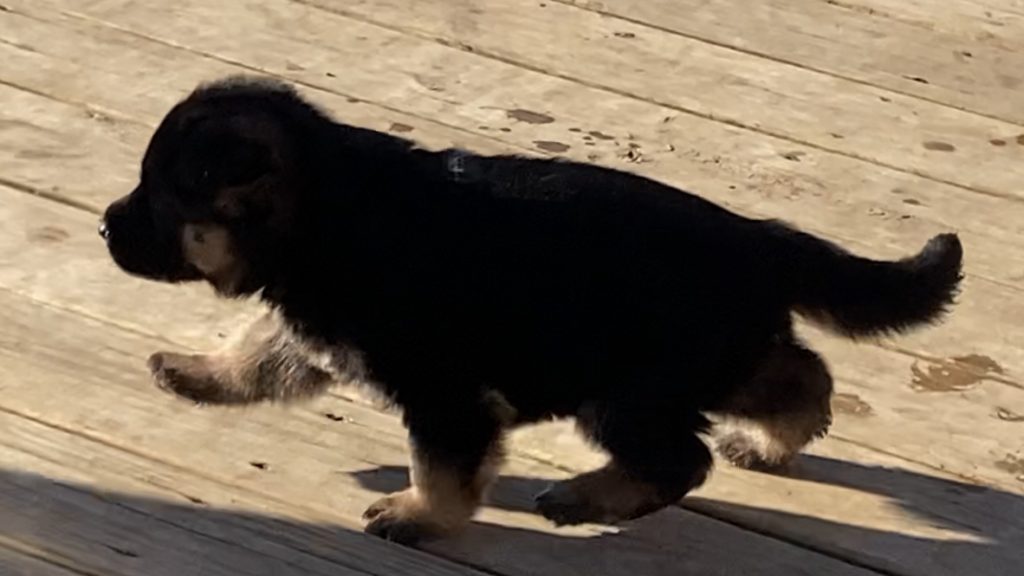
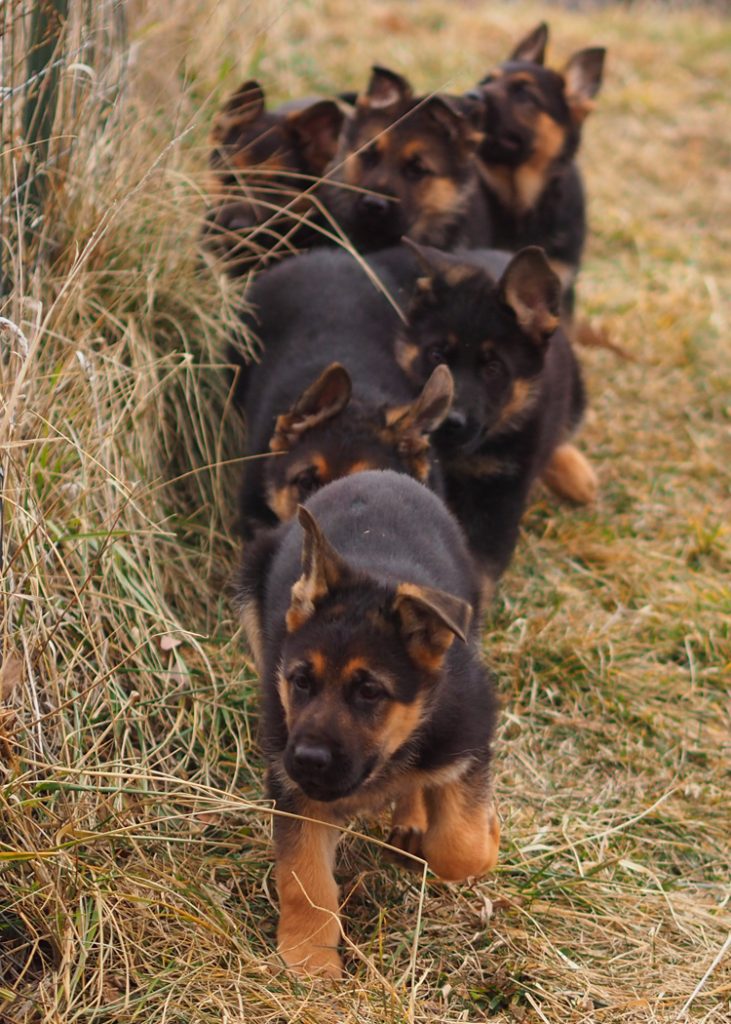
Remember, the goal is to provide a well-rounded and balanced approach to exercise that supports your German Shepherd puppy’s physical and mental development without causing harm. Slats and treadmills are a bad idea for german shepherds as it makes the movement choppy due to the short bay and unnatural motion of stride.
VR: Can you share your views on the diet / nutritional requirements of the GSD ? What special supplements do you use?
AK: I fully endorse the principle that the less processed the food, the better it is for dogs, and this concept holds true not only for German Shepherds but for all dog breeds and even humans. The idea of providing unprocessed, natural foods is rooted in the understanding that such a diet aligns more closely with the evolutionary dietary needs of dogs. In this context, your approach to feeding your dogs with unprocessed raw meat, including muscle and organ meat, is in line with the ancestral diet of dogs, which primarily consisted of prey animals. This diet provides a host of benefits:
● Nutrient Density: Raw meat and organs are rich in essential nutrients such as protein, vitamins, and minerals, which are essential for a dog’s overall health and well-being.
● Bioavailability: The nutrients in unprocessed foods are typically more bioavailable, meaning they are easier for the dog’s body to absorb and utilize.
● Natural Enzymes: Raw food contains natural enzymes that can aid in digestion and improve nutrient absorption.
● High-Quality Protein: Dogs are indeed primarily carnivores, and animal-based protein sources provide the amino acids necessary for metabolic homeostasis and muscle maintenance.
The inclusion of eggs, chicken, red meat, yogurt, and fish (excluding larger fish due to mercury concerns) adds variety to the diet, which can help ensure a broad spectrum of nutrients. Diversity in protein sources also helps address potential food sensitivities or allergies that some dogs may have.
I would refrain from endorsing specific kibble brands or supplements, it’s important to acknowledge that dietary needs can vary among individual dogs. Factors such as age, activity level, and any existing health conditions should be considered when formulating a balanced diet.
VR : What would you like to see being done for the betterment of the breed in India? Please share your insights and what could be done to implement them?
AK: Giving Back to the Breed:
● Education and Awareness: Sharing accurate and up-to-date information about responsible breeding practices, health considerations, and breed standards through online platforms, articles, or workshops can help educate others in the dog community.
● Community Involvement: Active participation in breed clubs, dog shows, and events can contribute to the breed’s visibility and success. By attending and engaging, breeders can foster a sense of camaraderie and collaboration within the community.
● Supporting Research: Contributing to or supporting research projects related to breed health, genetics, and behavior can have a positive impact on the breed’s well-being and understanding.
● Open Communication: Providing a platform for open communication among breed enthusiasts, sharing experiences, challenges, and successes, can help create a supportive network.
Mentoring Upcoming Breeders and Trainers:
● Sharing Knowledge: Experienced breeders can offer insights, guidance, and knowledge to newcomers. This can include sharing information about breeding practices, raising puppies, health considerations, and training approaches.
● Hands-On Guidance: Offering practical guidance and support, such as observing training sessions or assisting in whelping, can provide invaluable learning experiences.
● Encouraging Ethical Practices: Emphasizing the importance of ethical breeding, responsible ownership, and sportsmanship sets a positive example for newcomers.
● Stress on Lifelong Learning: Encouraging ongoing learning and development by recommending books, seminars, workshops, and online resources ensures that newcomers stay updated on the latest information.
● Promoting Networking: Encouraging interaction with other breeders, trainers, and enthusiasts allows newcomers to learn from a variety of perspectives.
● Offering Constructive Feedback: Providing thoughtful feedback on breeding plans, dog training techniques, and other aspects of the breed can help newcomers refine their practices.
● Mentorship Programs: Establishing formal mentorship programs within breed clubs or organizations can create structured opportunities for newcomers to learn from experienced individuals.
By actively participating in these ways, experienced breeders can contribute positively to the breed’s future and support the growth and development of responsible breeders and trainers within the community.
VR: ABHAI ji, on behalf of the committee of the Kennel Club of India and the IKG editorial board and our readers, I thank you once again for your time and for giving us this wonderful interview. I take this opportunity to wish you all the best in your future endeavors in breeding and showing your lovely dogs.
Dear Venkatesh, I would like to extend my heartfelt gratitude to the committee of the Kennel Club of India, the IKG Editorial Board, and your esteemed readers for the opportunity to share my thoughts and experiences in the interview. It was truly an honor to be a part of this engaging conversation.
Your warm wishes and encouragement for my future endeavors in breeding and showing my beloved dogs mean a lot to me. It’s the support and enthusiasm of fellow enthusiasts like you that fuel my passion for this rewarding journey. I am deeply
appreciative of your kind words and well wishes.
I am committed to continuing my efforts in the world of German Shepherd Dogs, striving to uphold the high standards that this community represents. With your blessings and support, I am confident that there are many exciting chapters ahead for us.
Once again, thank you for this wonderful opportunity, and I look forward to staying connected with the Kennel Club of India, the IKG editorial board, and all the dedicated readers who share a love for our four-legged friends.
